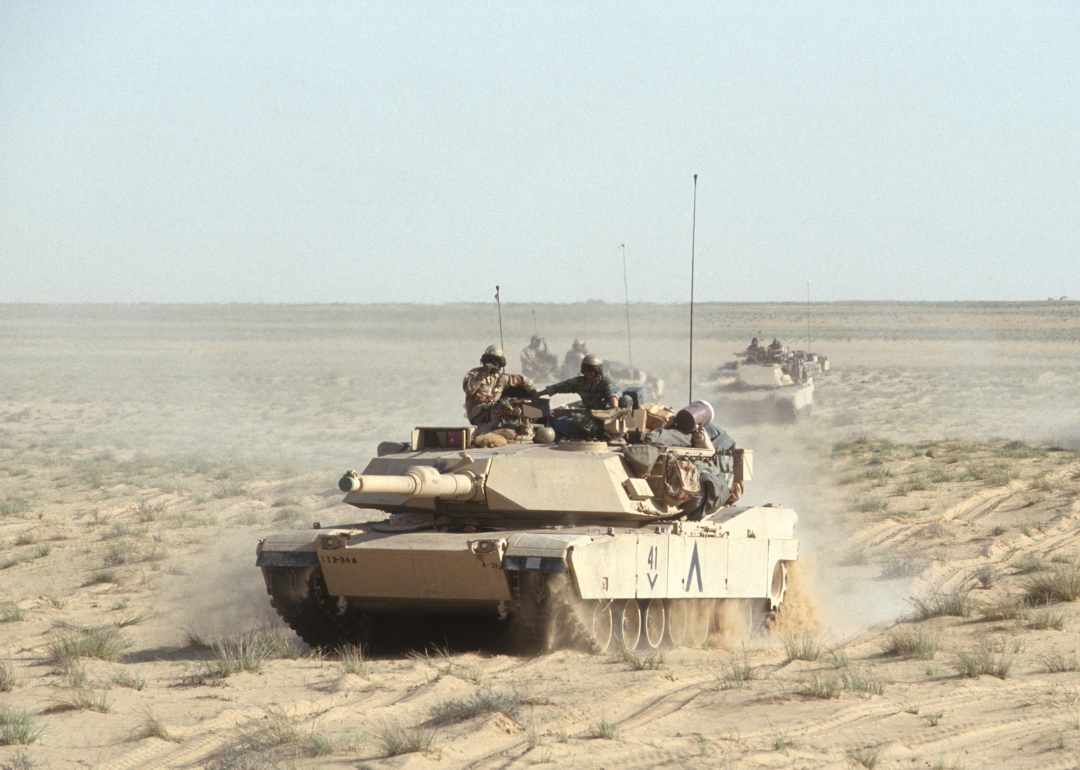
60 historic photos from American military history
60 historic photos from American military history
On the world stage, as a leading military superpower, America has been involved in wars and conflicts since the 18th century.
Each U.S. military branch—from the Army and Marine Corps to the Air Force, Navy, and Coast Guard—has gone through dramatic strategic and technological advances throughout its history. Sailing vessels armed with harpoons and single-shot cannons gave way to diesel-powered ships capable of transporting entire fleets from one side of the planet to another and protecting the planet's oceans. Aircraft evolved from biplanes to the modern jet-powered fighters we see today. Warfare went from lines of troops and trenches to highly strategic, multifaceted combat leaning more on technology than on individual soldiers, though the military remains only as strong as the people who comprise it.
America's military history includes countless moments of triumph and loss during conflicts in locations both at home and abroad. From the American Revolution to the end of the Gulf War, over 42 million people have served in the United States military during wartime. In more recent years, it's estimated that an additional 2.9 million served in post-9/11 related operations.
The losses suffered are countless, and only a fraction of their work, heroism, and sacrifice stories are known. Often a single picture says more than words ever could. To that end, Stacker compiled both well-known and lesser-known photographs from Getty Images—each with its own place in American military history. Shown here are mothers, sons, fathers, and daughters who were drafted or enlisted, and who served their country throughout the generations. These snapshots offer a window into the lives of veterans and civilians during various moments in military history.
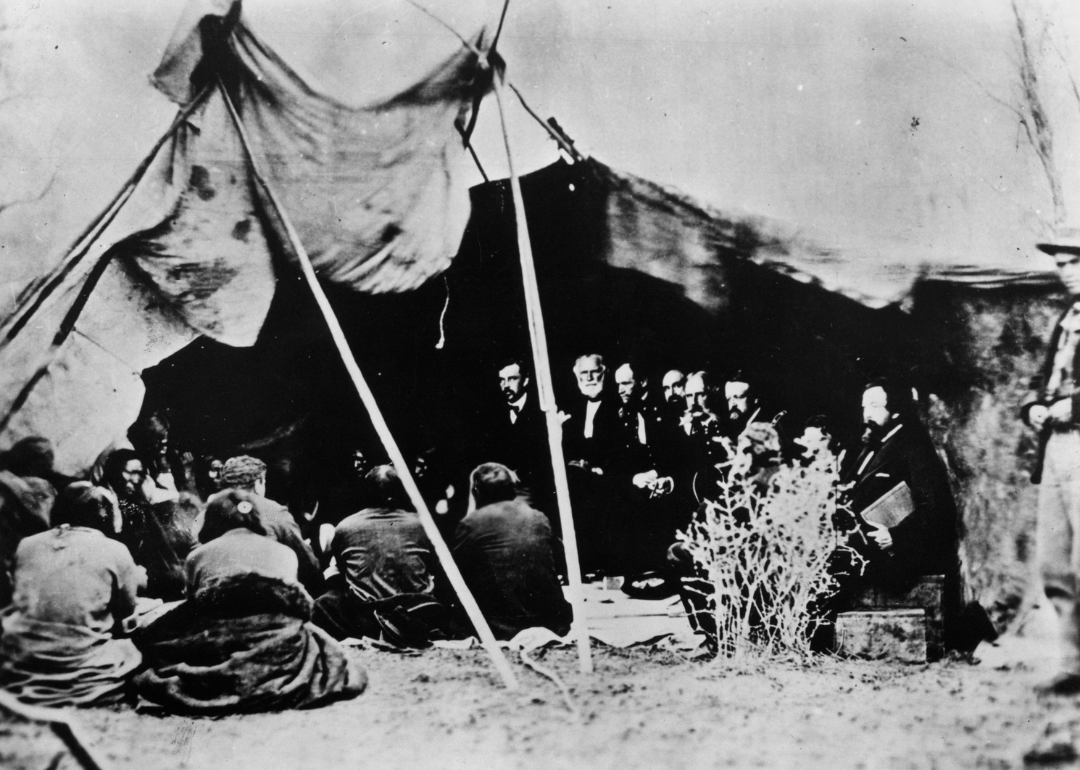
1868: Sioux Wars
Several conflicts took place in different territories of the Great Plains between American troops and Sioux warriors from 1854 to 1891. The tribes involved in the battles were the Lakotas and the Dakotas, both subcultures of the Sioux, with help—at one time or another—from the Cheyenne, Arapaho, Kiowa, and Comanche. The Sioux were fighting to keep and expand the compensations and territories they had conquered before the signing of two treaties, including the Sioux Treaty of 1868, which concerned the settlement of the Black Hills, while the Americans needed a safe passage to lands close to mines and other areas rich in natural resources.

1862: Abraham Lincoln at Antietam during Civil War
The battle of Antietam was one of the most important wins for the Union troops, though it was also known as the bloodiest battle in United States history. Shown here is President Abraham Lincoln with General George B. McClellan at his headquarters at Antietam on Oct. 3. From left are: General George W. Morell, Col. Alexander S. Webb, General McClellan, scout Adams, Dr. Jonathan Letterman, unidentified officer, President Lincoln, Col. Henry Hunt, General Fitz, John Porter, and an unidentified officer.
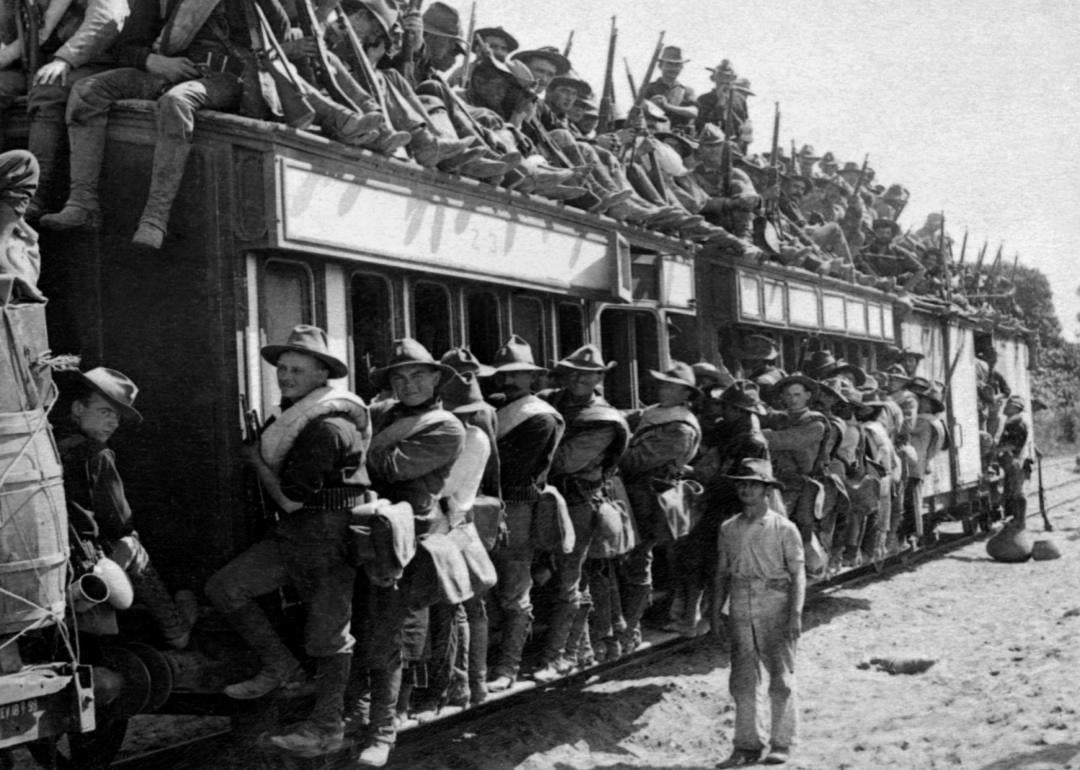
Philippine–American War
The consensus among historians is that approximately 200,000 Filipino civilians died in the Philippine-American war of 1899-1902, alongside 4,200 fallen U.S. soldiers and more than 20,000 Filipino soldiers and guerillas. The U.S. government had offered to fight alongside Filipinos against Spain and recognize their independence once they declared victory. However, President William McKinley annexed the islands to the U.S. under the Treaty of Paris. Despite years of conflicts and war crimes committed by both sides, the independence of the Philippines didn't come until 1946 with the Treaty of Manila.

1915: Mexican Border War
Beginning in 1910, Mexican rebels and American soldiers engaged in a series of military confrontations on the Texas-Mexican border, skirmishes that would continue until 1919, just after the end of World War I. The pinnacle of these border skirmishes came in 1916 when revolutionary leader Francisco "Pancho" Villa attacked the town of Columbus, New Mexico. The U.S. Army responded with a punitive expedition into northern Mexico aimed at capturing Villa. Though they failed to achieve this, American troops were able to kill two of his top lieutenants.
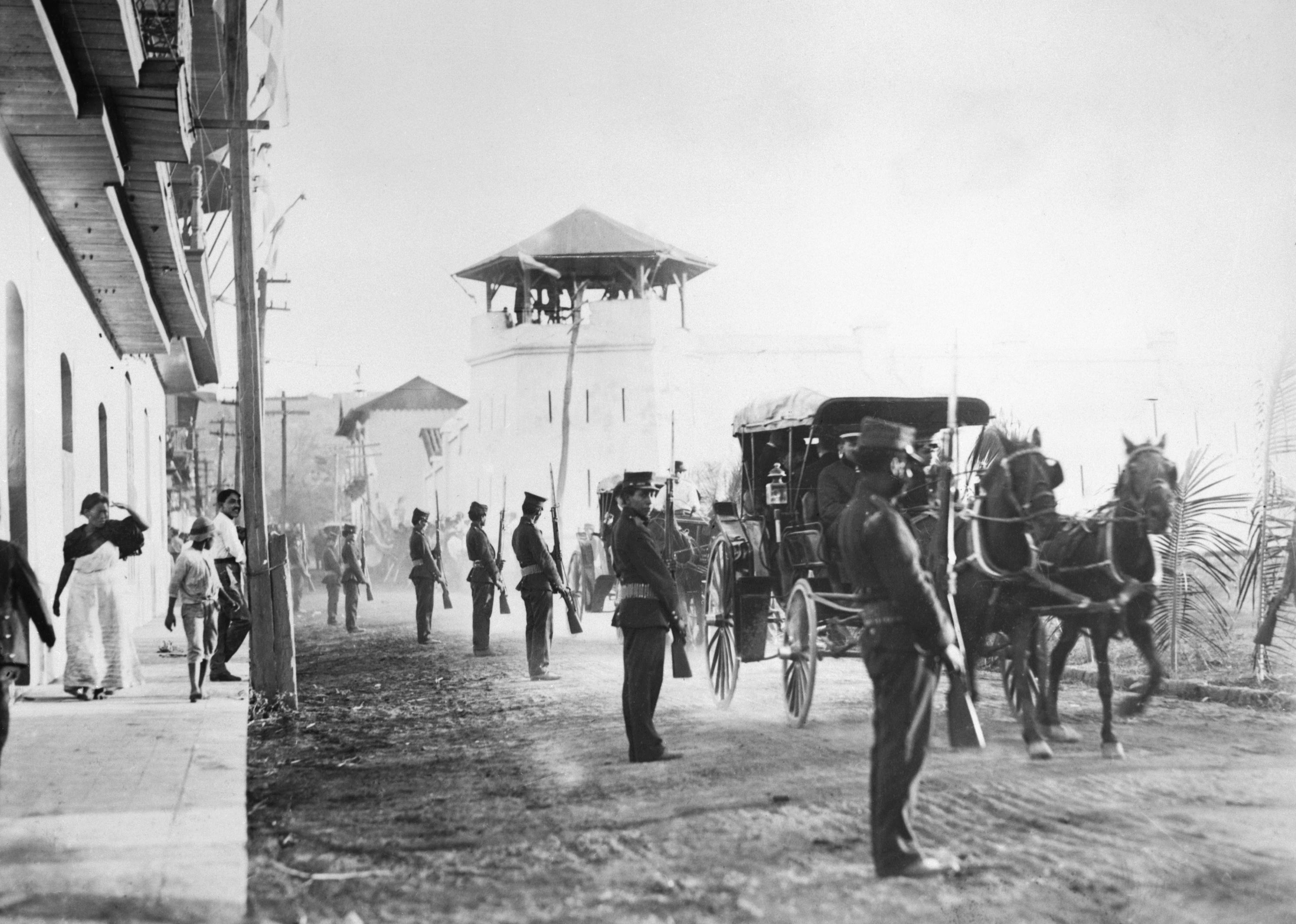
1927: US occupation of Nicaragua
The U.S. occupation of Nicaragua, which occurred from 1912 to 1933, was intended to stop any other country from building a canal that would allow marine transportation to cross Central America from the Caribbean Sea to the Pacific Ocean, a feat later achieved through the Panama Canal. The intervention was one of many military conflicts known as the Banana Wars, during which the U.S. Marine Corps occupied several Central American and Caribbean nations, many times aided by the Navy and Army.
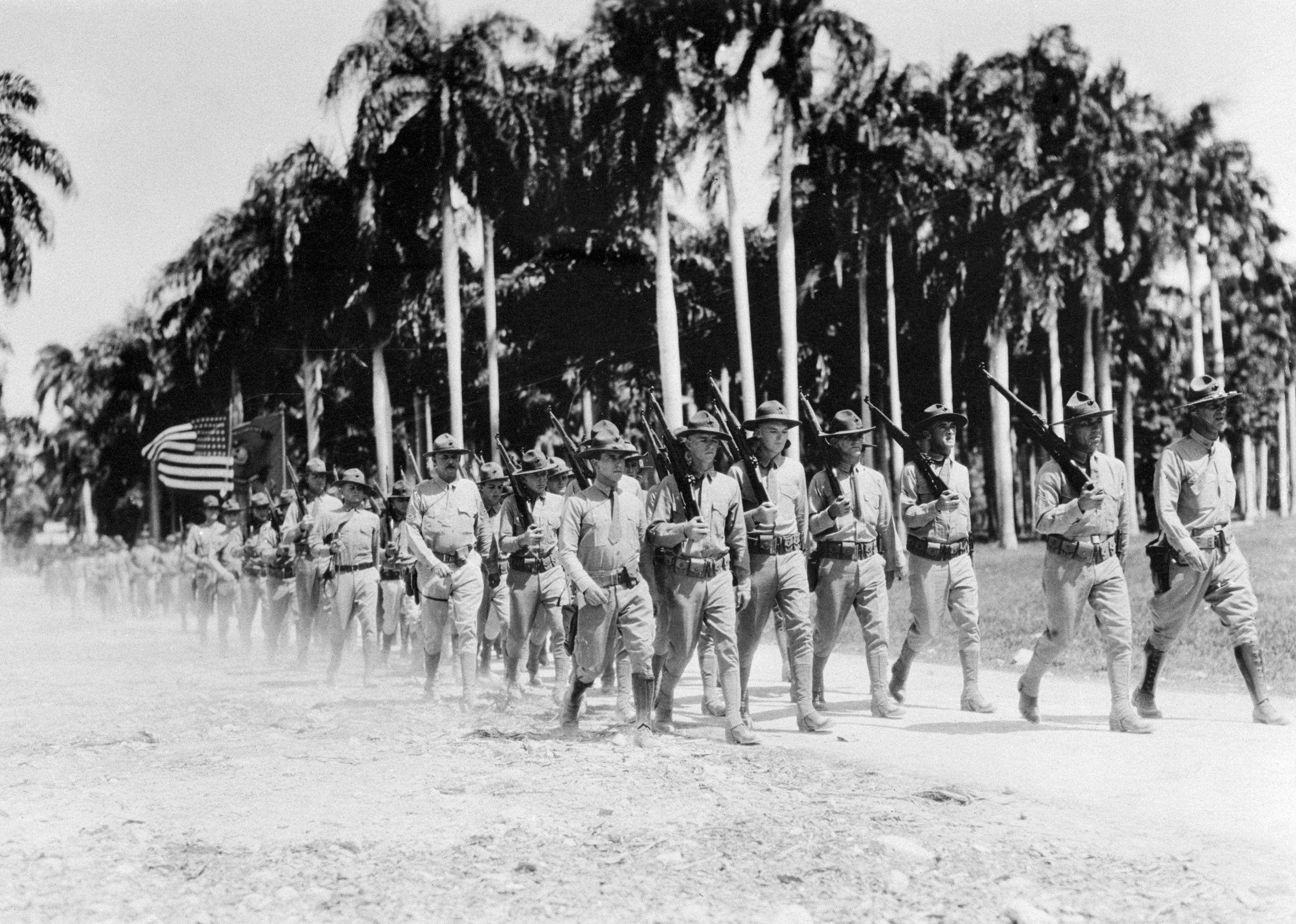
1934: US occupation of Haiti
In 1915, following the assassination of Haitian President Jean Vilbrun Guillaume Sam, President Woodrow Wilson ordered the occupation of Haiti under the guise of ensuring stabilization within the region. However, underlying the occupation were the interests of various American businessmen in exploiting the country financially. The National City Bank of New York had withheld funds from Haiti and paid rebels to destabilize the nation with the goal of prompting an American intervention that would help grow U.S. private investments. This occupation did not end until 1934, when President Franklin D. Roosevelt ordered the withdrawal of troops from Haiti.
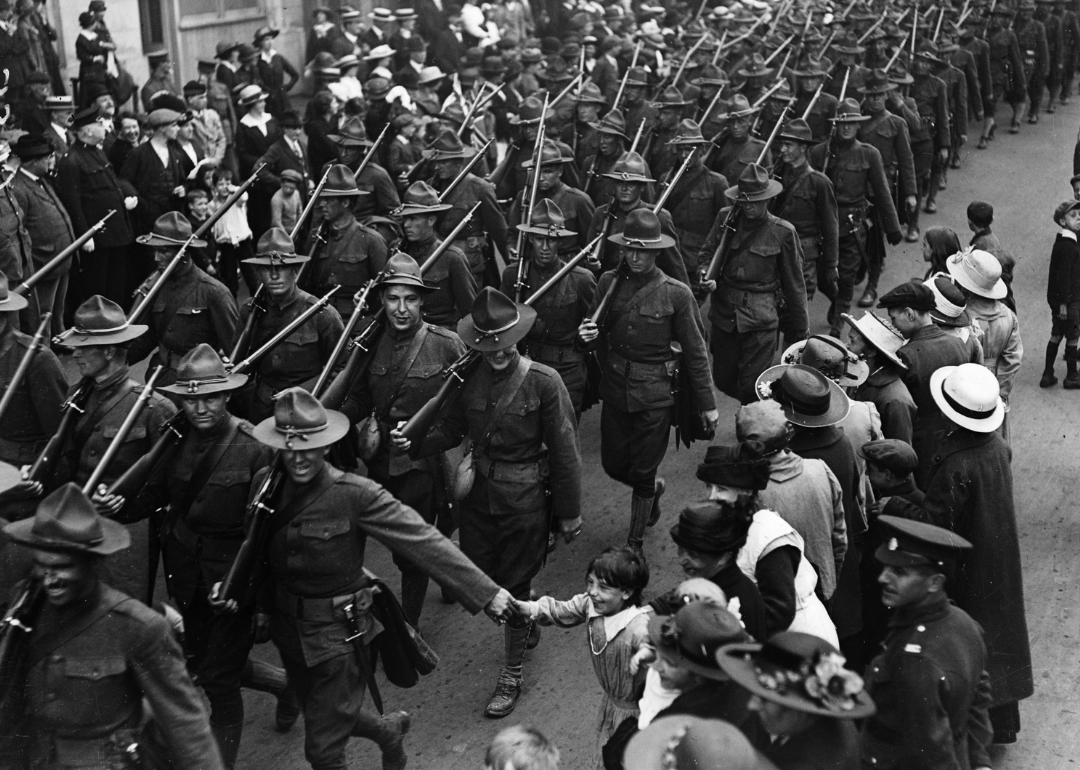
1917: Welcoming
An American soldier in August of 1917 shakes hands with a young member of the watching public as his troop parades through the streets of London. The first world war, also known as The Great War, began in Europe in 1914. After the United States declared war on Germany in 1917, they remained involved until the war's end in 1918.
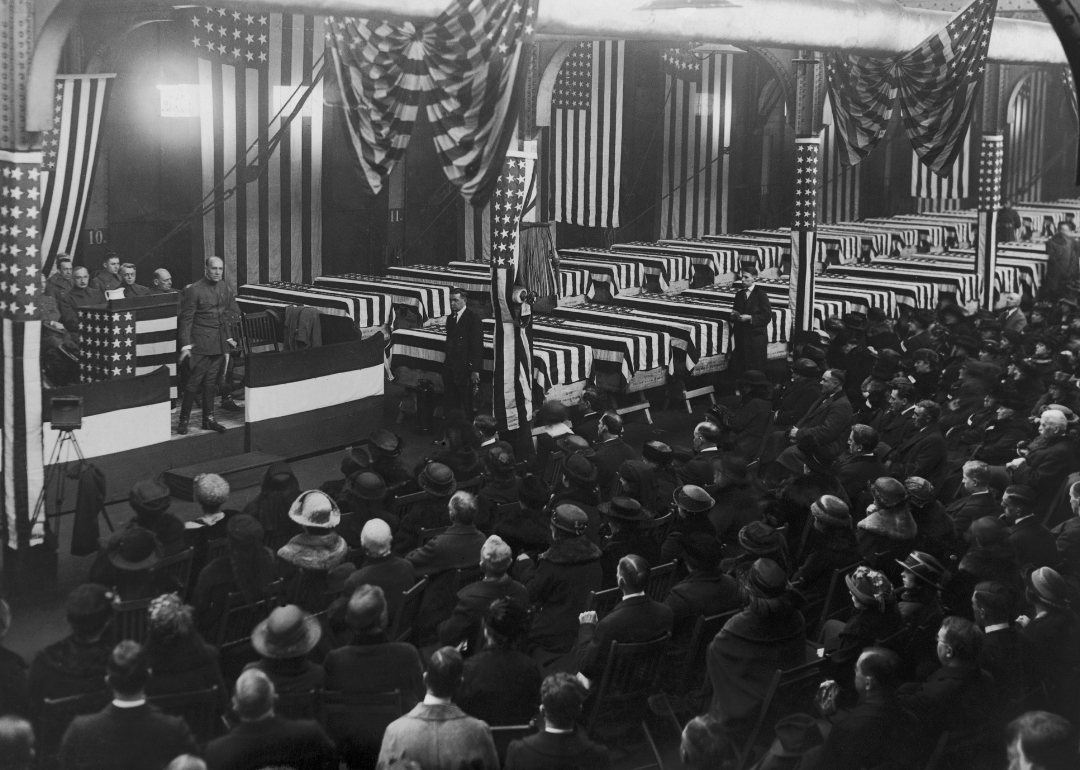
1918: Service for war dead
A service is held in Hoboken, New Jersey, for American soldiers who died on the battlefields of France during World War I. The war claimed the lives of over 100,000 American service members and injured more than twice that amount.

1918: Newspaper headlines on Armistice Day
Jubilant Americans in Washington D.C. show newspaper headlines announcing Germany's surrender, ending World War I, on November 8, 1918. The United States sent over 1 million troops into Europe alone throughout the war.
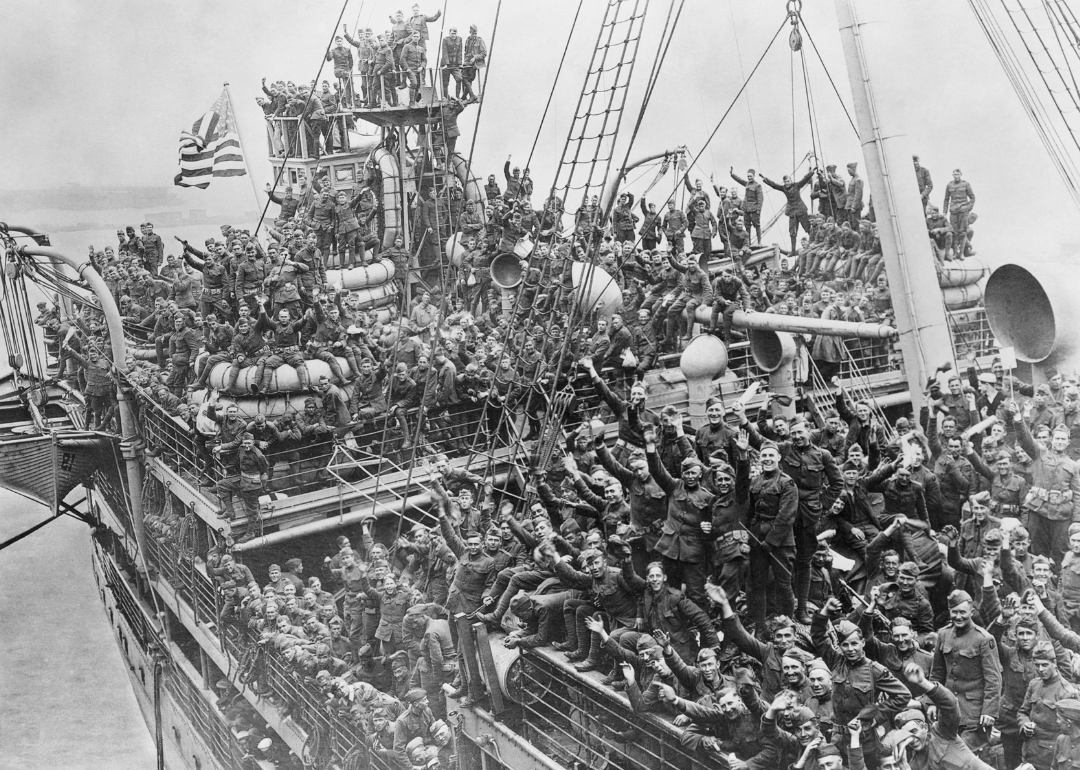
1919: Ship of soldiers returning home
Soldiers on the USS Agamemnon cheer as they return home to Hoboken, New Jersey, from the battlefields of France. The deck of the ship is crowded with cheering soldiers. Over 4.5 million Americans served the United States' military war efforts.
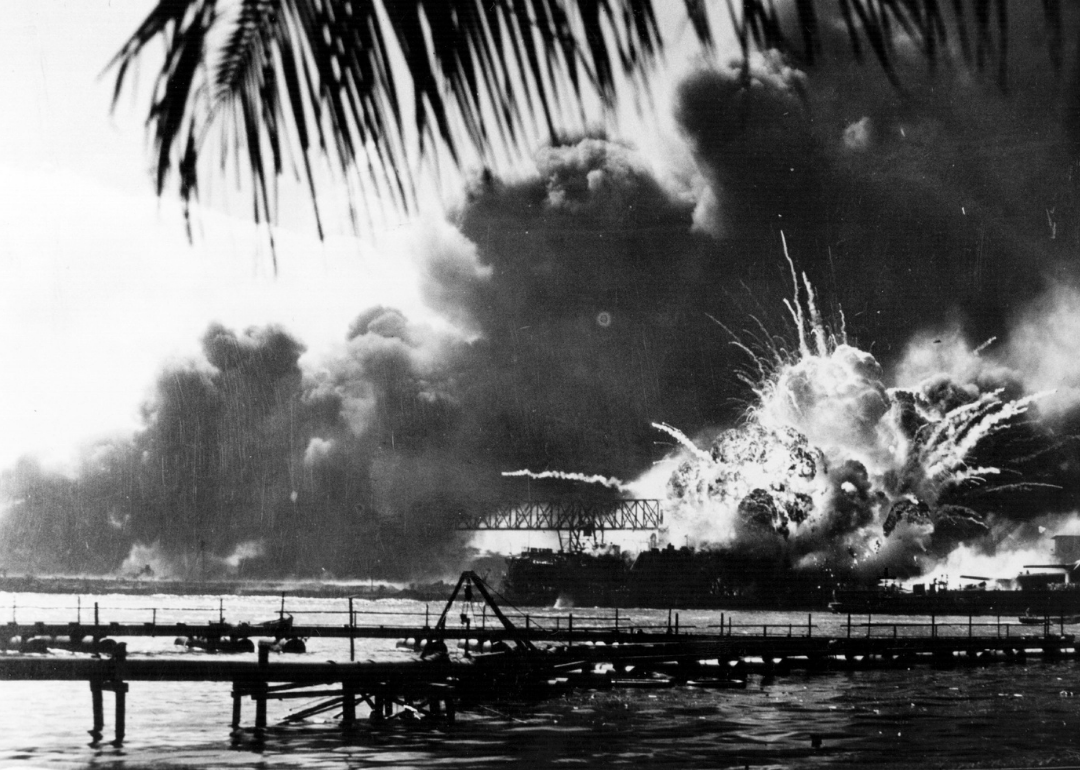
1941: Attack on Pearl Harbor
The American destroyer USS Shaw explodes during the Japanese attack on Pearl Harbor, home of the American Pacific Fleet during World War II. The attack from Japan came as a complete surprise and was followed soon after by Italy and Germany declaring war on the United States.
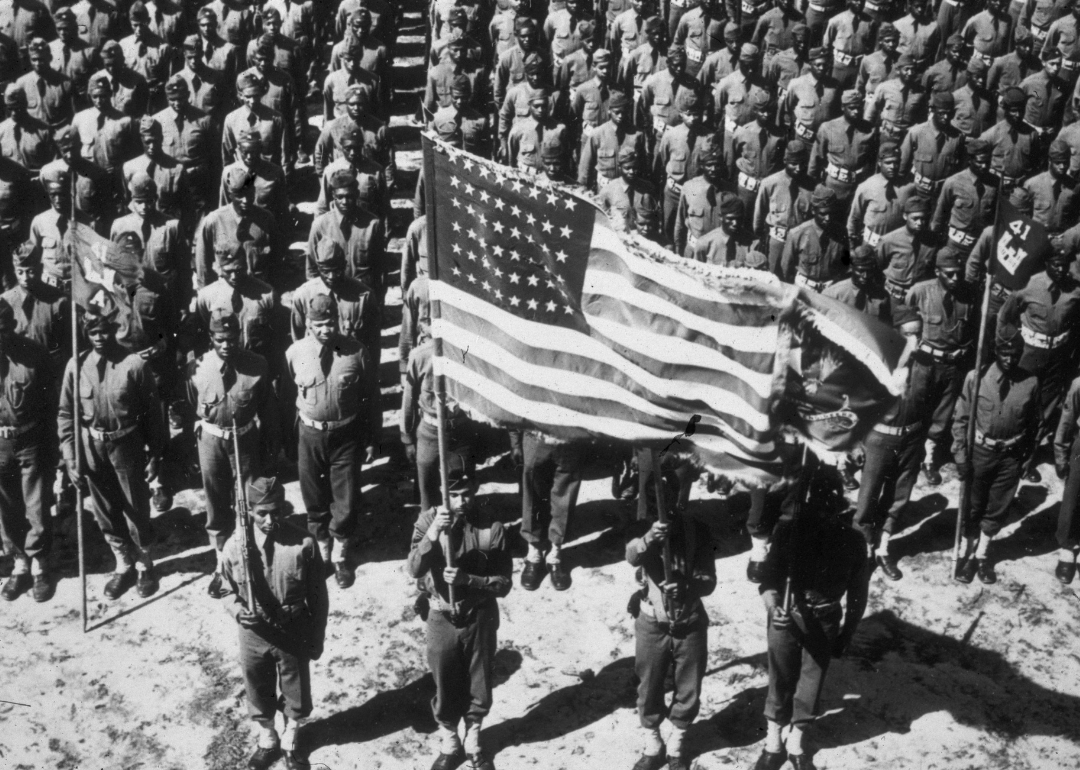
1942: Battalion of army engineers
Group view of the 41st Corps of Engineers soldiers, an African American army battalion, standing in formation and holding the American flag in Fort Bragg, North Carolina. African American soldiers still fought in segregated units during World War II. The United States military did not desegregate units until 1948.
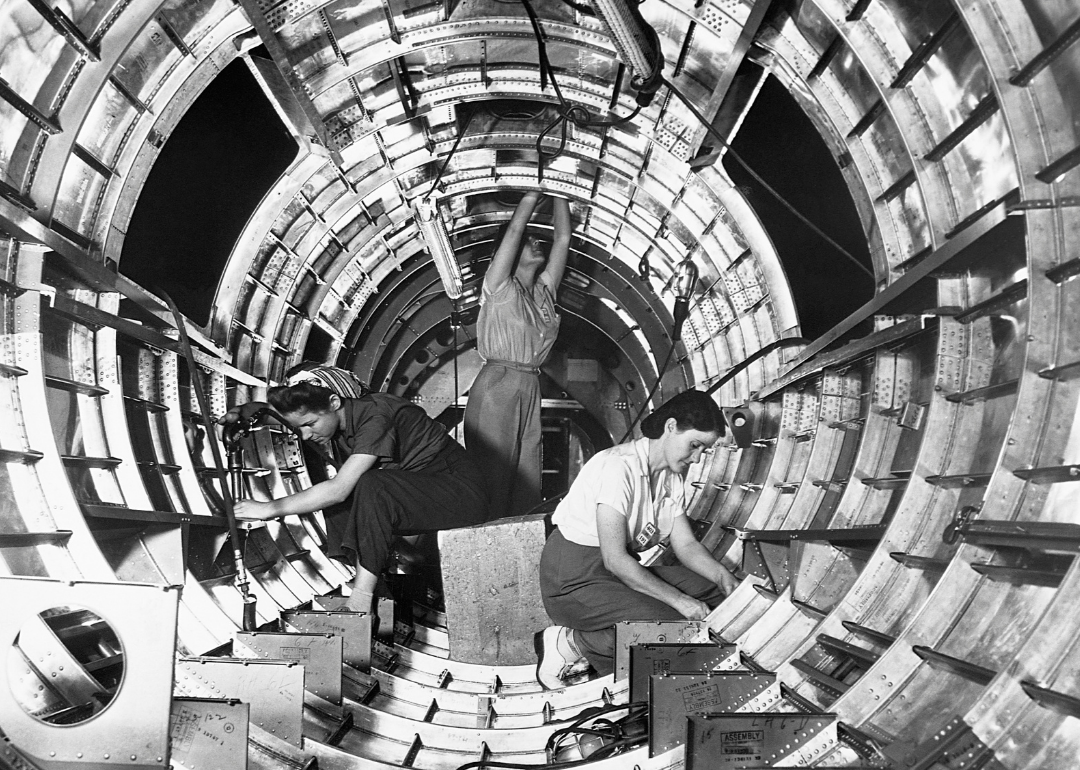
Circa 1940s: Women building a bomber
Women workers assemble the tail fuselage of a B-17F bomber, also known as a "Flying Fortress," at the Douglas Aircraft Company in Long Beach, California. Millions of women worked in factories and volunteered for the Red Cross in order to serve war efforts during WWII.
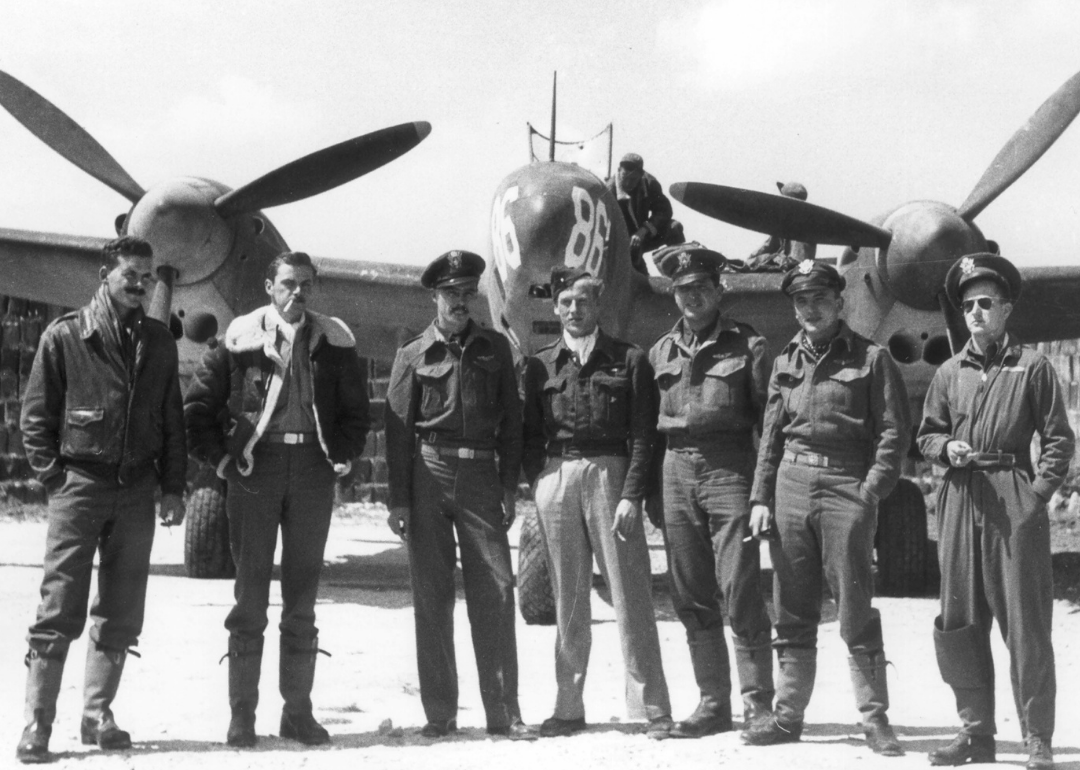
1943: Lockheed P-38 Lightning
Wing Commander Adrian Warburton DSO DFC (center) poses with the first United States Army Air Forces unit in Malta. American pilots shown from left to right include German, Spencer, Sculpone, Webb, Sugg, and Bury. The United States effort involved over 16 million servicemembers.
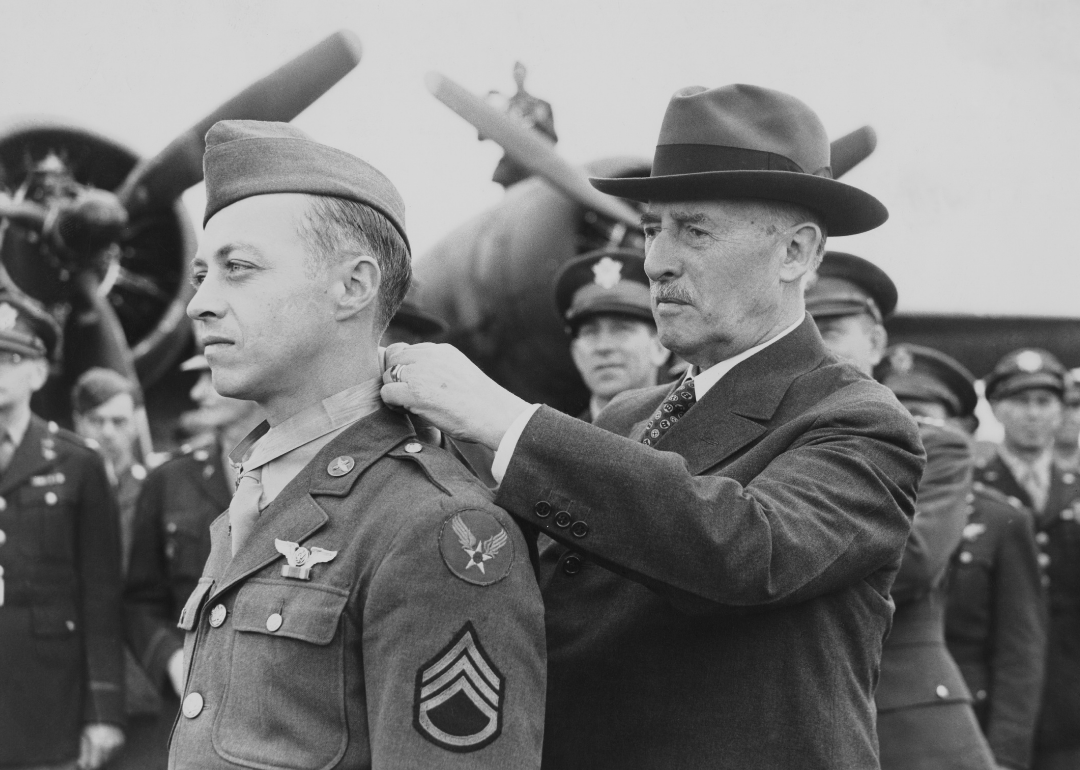
1943: Medal of honor
Staff Sergeant Maynard Harrison Smith of the United States Army Air Forces is decorated with the Congressional Medal of Honor by Henry L. Stimson, the U.S. Secretary of War, on July 16, 1943. Smith was recognized for his conduct as a gunner aboard a B-17 Flying Fortress bomber during World War II. The medal symbolizes the greatest honor given by the military and has been awarded 3,515 times.
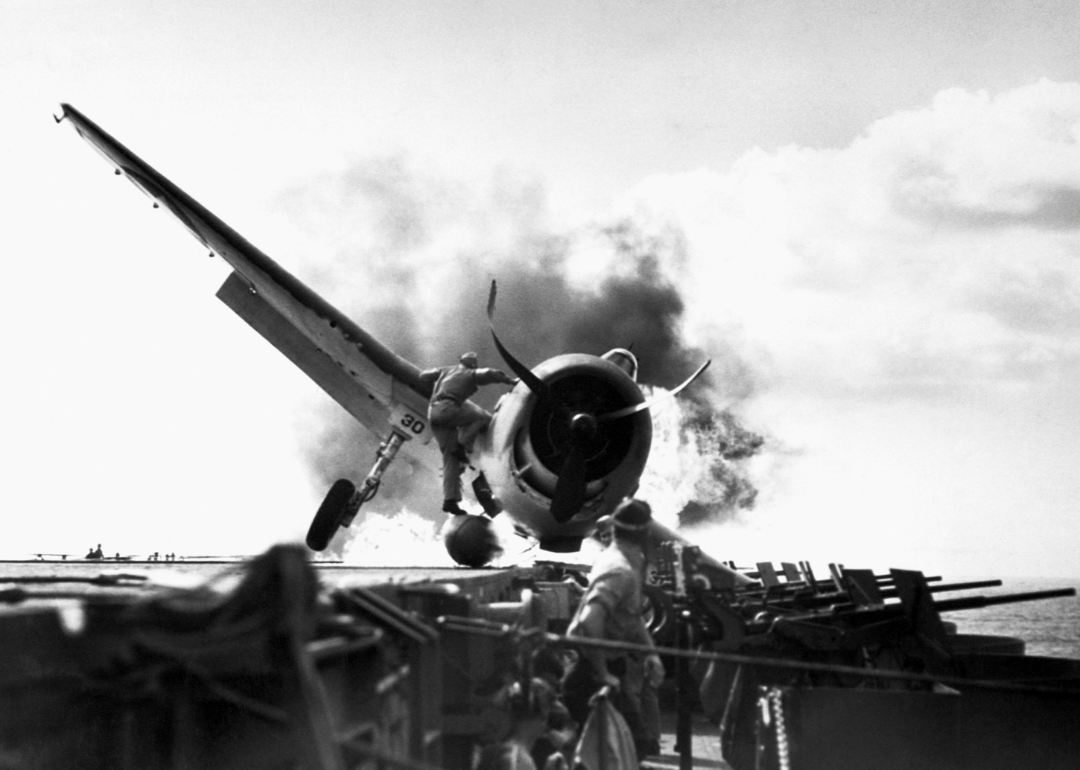
1943: Sailor rescuing pilot from a plane wreck
Lt. Walter Chewning, catapult officer aboard the U.S.S. Enterprise, clambers up the side of a downed F6F Hellcat to assist the pilot, Ensign Byron Johnson, from the flaming cockpit. The F6F Hellcat achieved a stunning 19:1 kill ratio during WWII, showing the dominance of the technology and the incredible skill of the pilots.
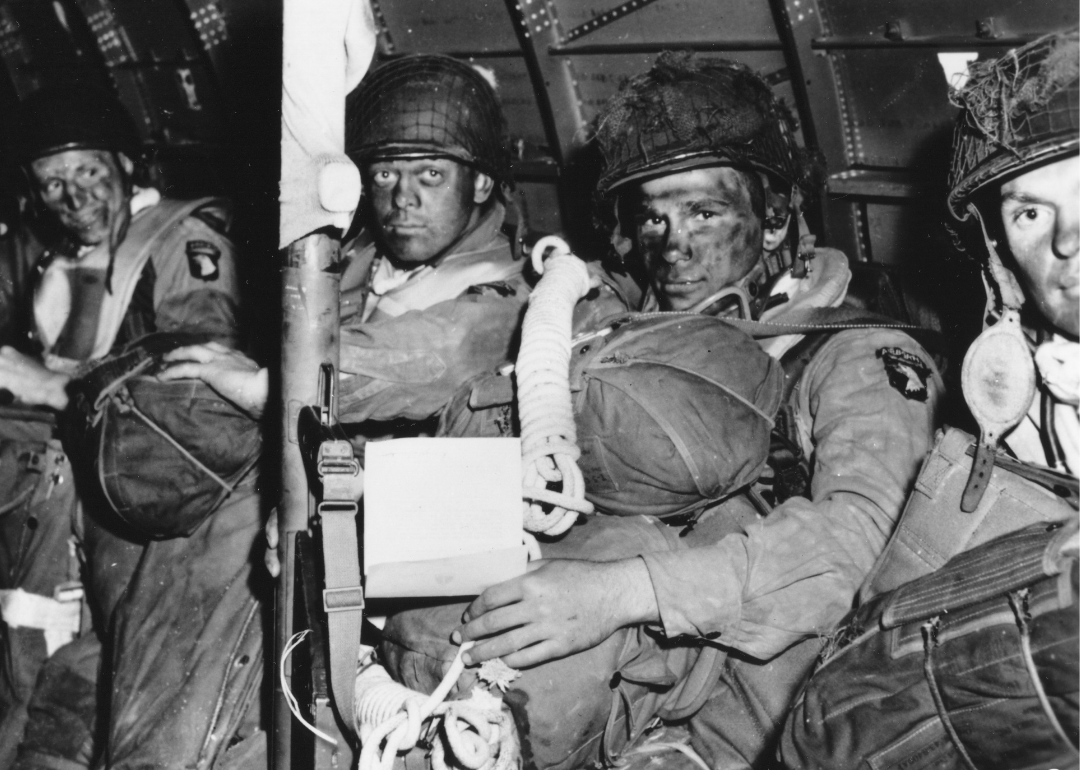
1944: Paratroopers preparing for D-Day
Resolute faces of paratroopers just before they took off for the initial assault of D-Day, June 6, 1944. The paratrooper in the foreground has just read General Eisenhower's message of good luck and clasps his bazooka in the other hand. The assault on the beaches at Normandy included the largest airborne force ever deployed up to that date.

1944: Operation Overlord
Pictured here are American assault troops landing at Omaha Beach in Normandy supported by naval gunfire. The battles at Normandy, which paved the way for the invasion of Europe, involved almost a quarter of a million casualties for the Allied Forces.
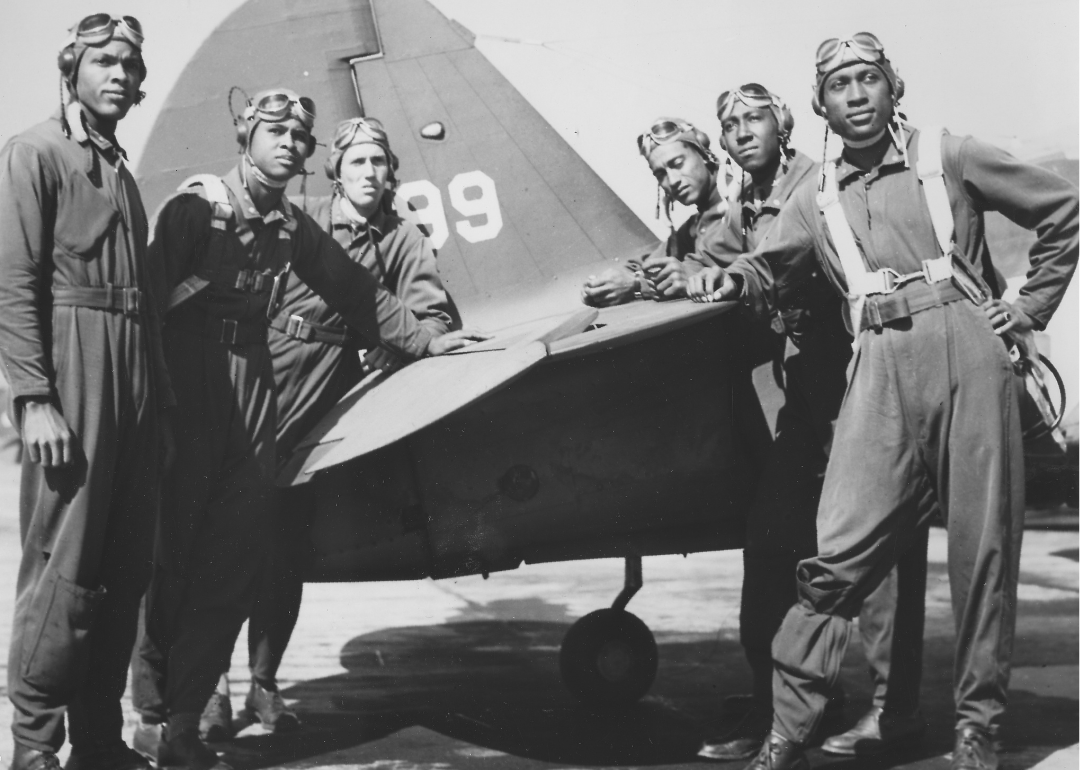
1944: Tuskegee Airmen
Tuskegee Airmen, with fighter aircraft, at Tuskegee Army Flying School during World War II, Tuskegee, Alabama, 1944. The success of these airmen helped in the breaking down of racial barriers in the war effort. They were known across Europe and Northern Africa for their heroism and bravery.
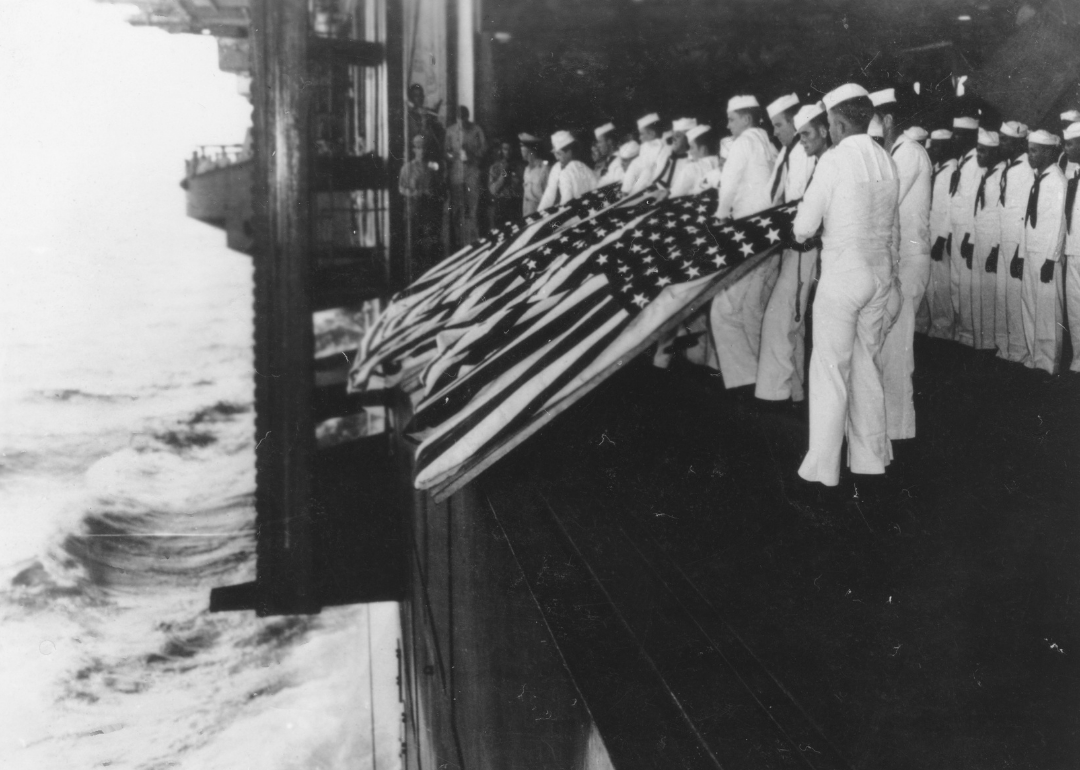
Circa 1940s: Burial at sea for USS Intrepid casualties
U.S. Navy sailors gather to honor shipmates killed in action with a burial at sea on board the USS Intrepid off Luzon in World War II. The United States reported 291,557 combat deaths throughout the duration of the war. The Navy alone suffered over 100,000 deaths.
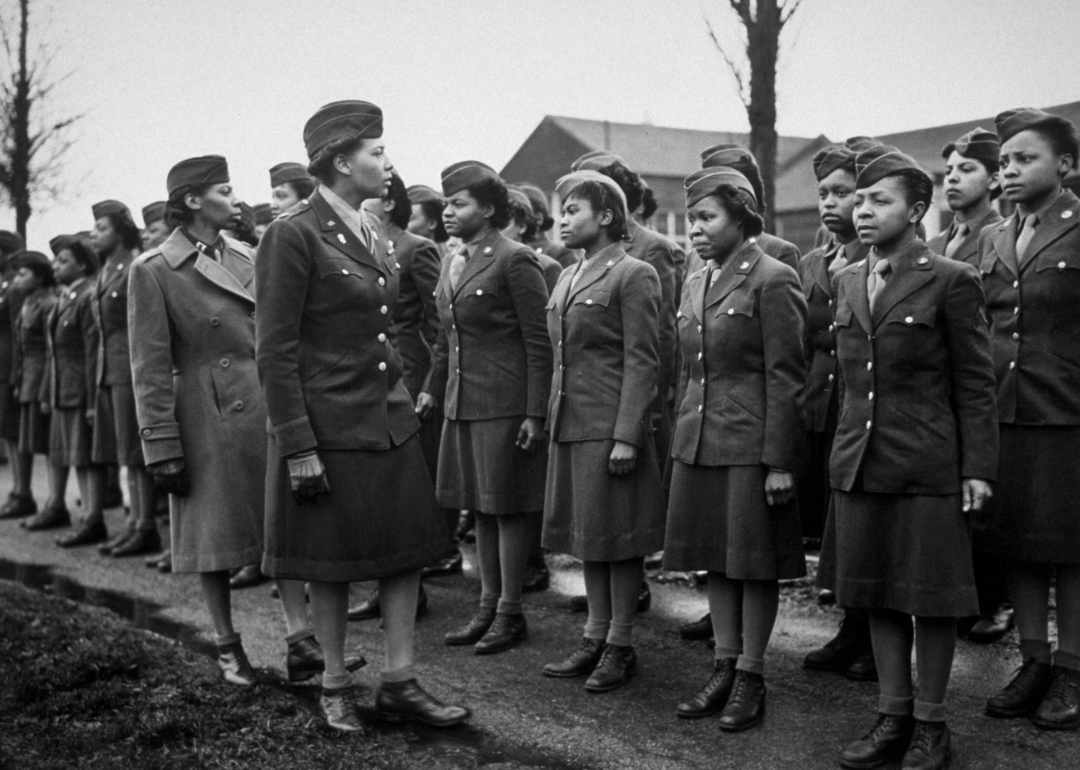
1945: Women's Army Corp
Major Charity Adams addresses a contingent of the Women's Army Corps. The group show was known as the Six Triple Eight and was the first group of Black women to be deployed in Europe to sort mail for troops overseas. Though thought to have been set up to fail, they ended up running the most efficient mail service in all of Europe during the war.
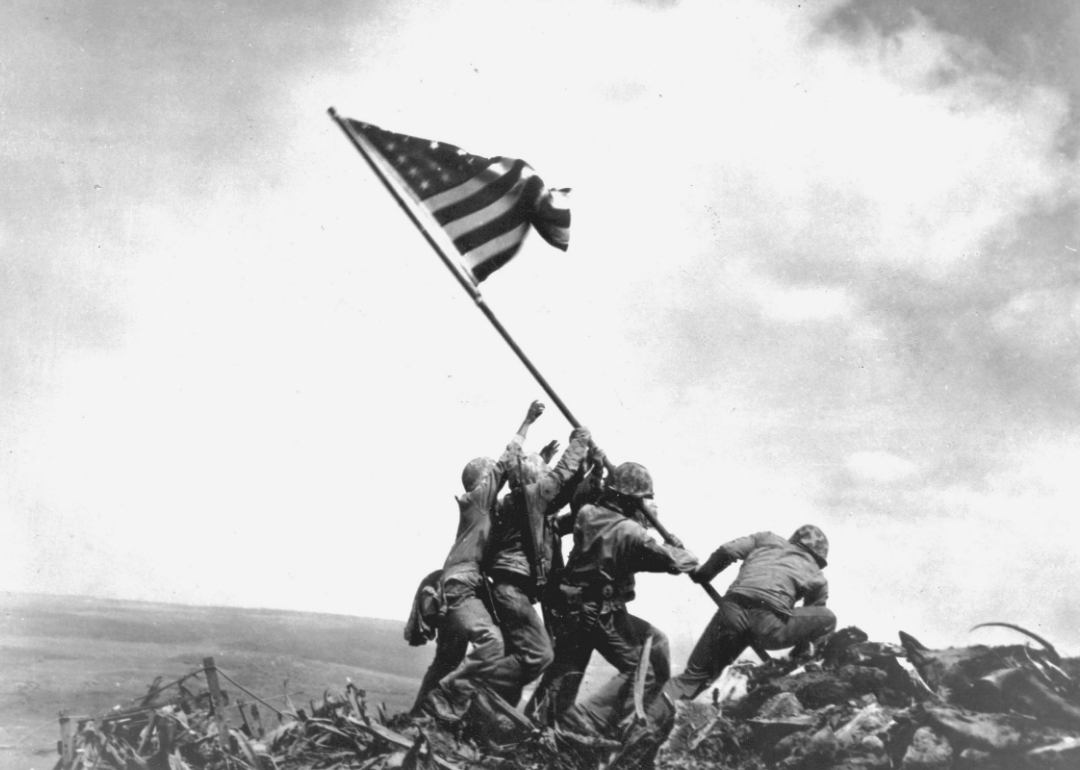
1945: Raising the flag on Iwo Jima
In one of the most iconic photographs in American military history, pictured here are members of the United States Marine Corps 5th Division as they raise an American flag on Mount Suribachi during the Battle of Iwo Jima. In 2019, the Marine Corps positively identified the six men pictured as Corporal Harlon Block, Corporal Harold P. Keller, Private First Class Ira Hayes, Private First Class Harold Schultz, Private First Class Franklin Sousley, and Sergeant Michael Strank.
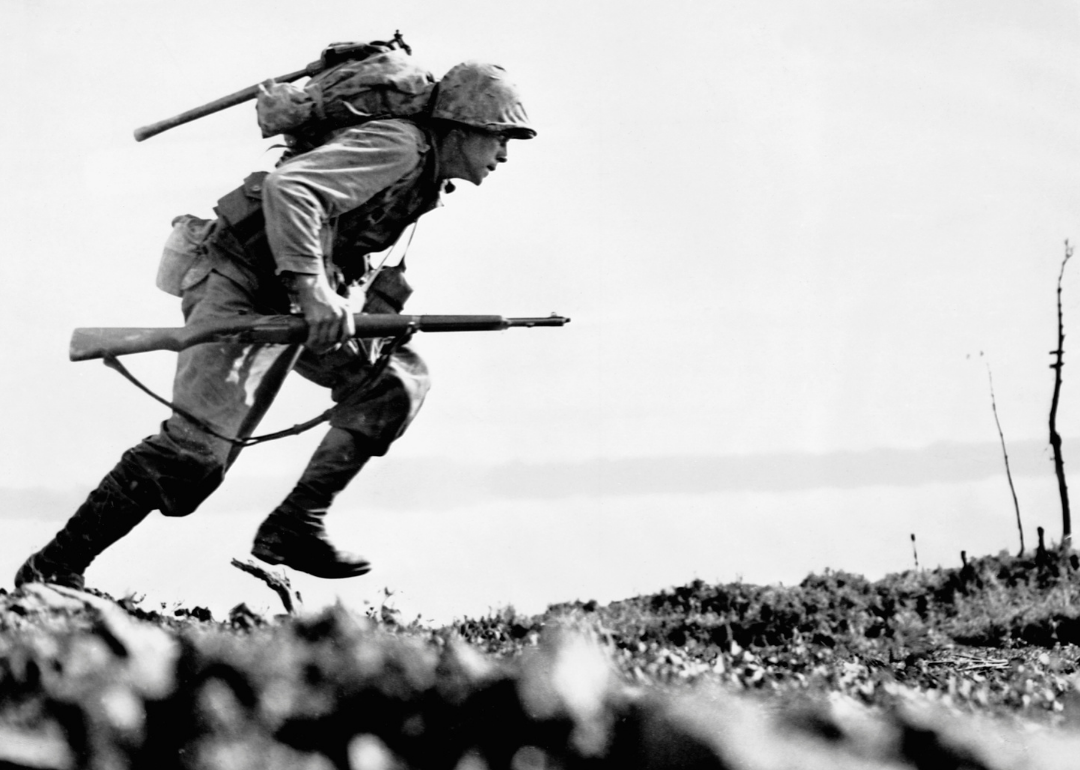
1945: Marine charging during Battle of Okinawa
A U.S. Marine charges forward through Japanese machine gun fire on Okinawa. Marines and infantry of the U.S. 10th Army controlled three-quarters of Okinawa three weeks after landing on the island on March 31, 1945. The allied invasion of Okinawa took three months and included 1,300 U.S. ships. More than 12,000 American servicemen from various branches of the military perished in the fight to take the island.
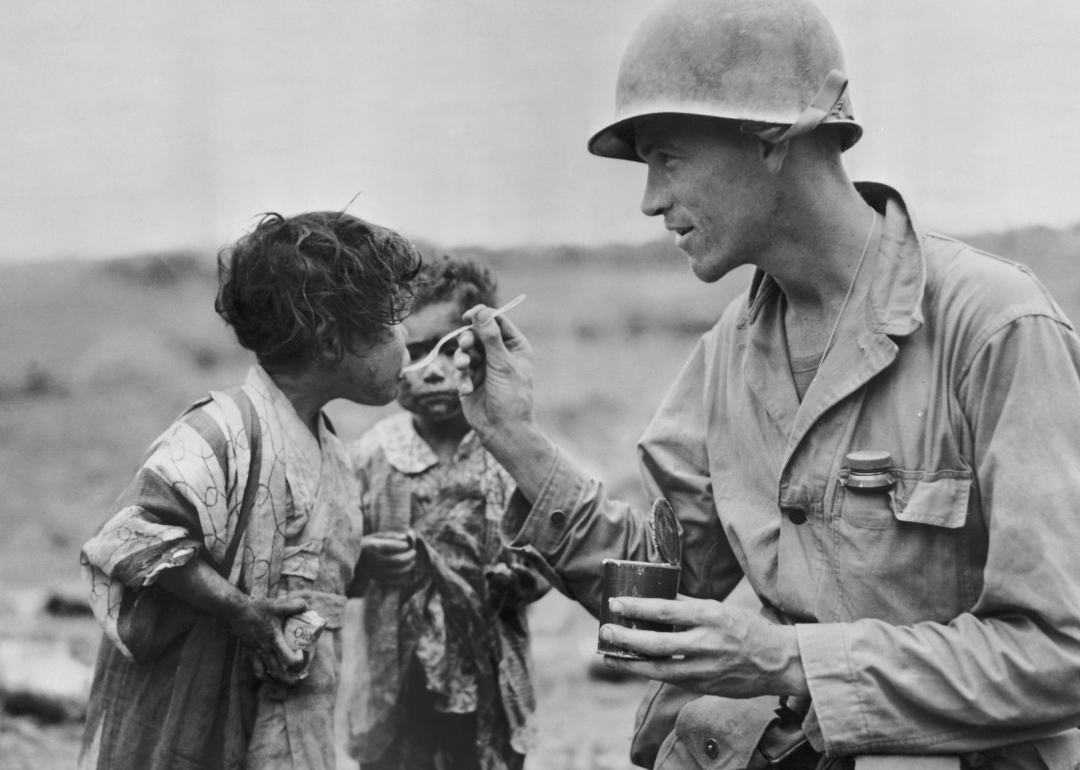
1945: Sharing food
An American serviceman shares his rations with two Japanese children in Okinawa, Japan, in 1945. Shortly after the Allied Forces took control of the island of Okinawa, which was to be used as a base for an attack on mainland Japan, the Japanese government gave in and offered an unconditional surrender.
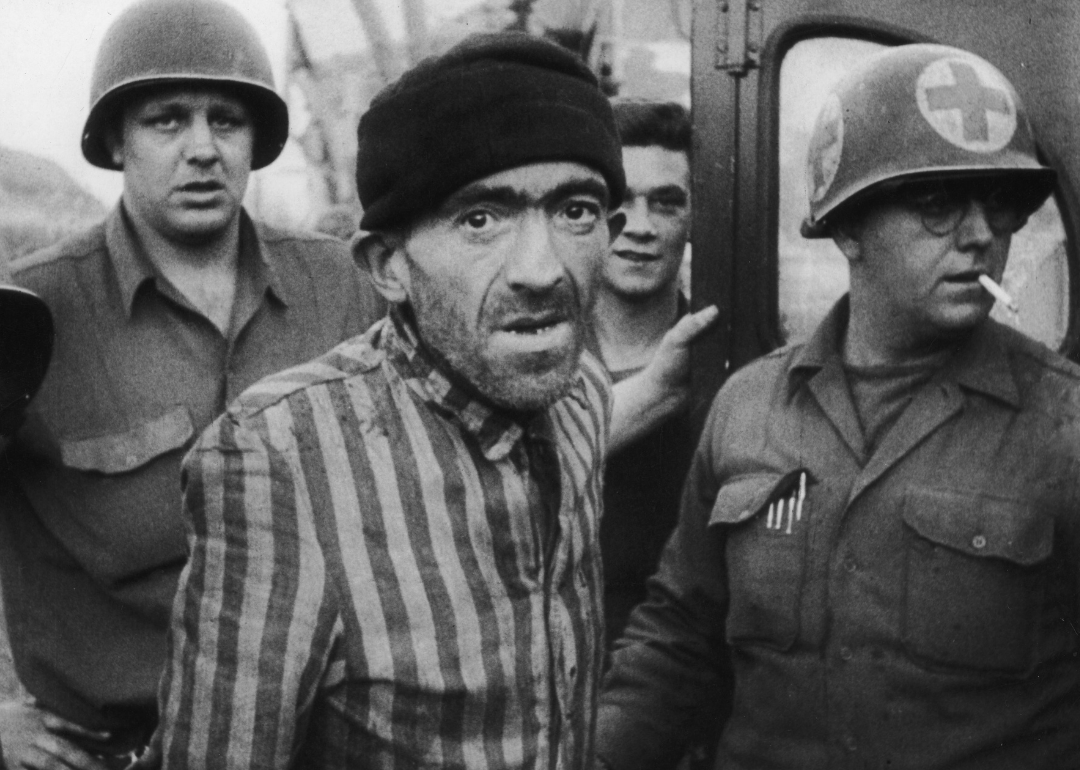
1945: Leaving Nordhausen
A survivor of the Mittelbau-Dora concentration camp at Nordhausen after the camp was liberated by the U.S. Army in 1945. It is commonly stated that over 6 million innocents were murdered by the Nazis during the Holocaust, though the actual number may be almost double that. The Nazis hid as much of the evidence of their atrocities as they could, so the exact number lost may never be known.
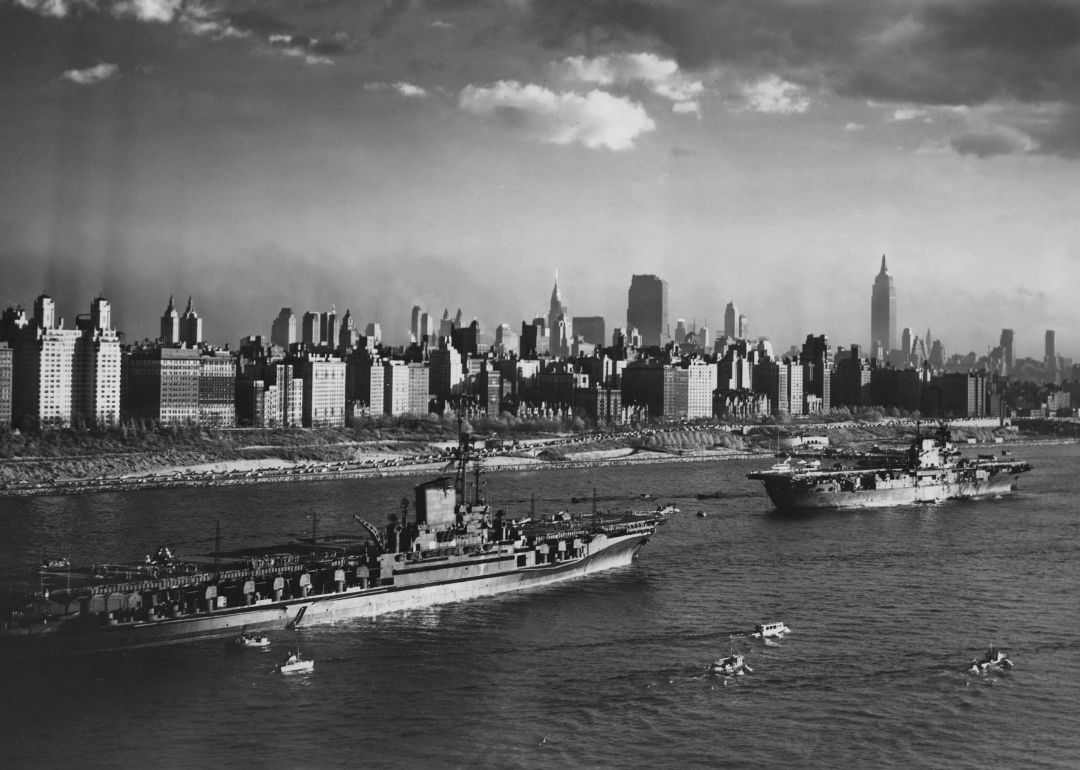
1945: Manhattan skyline
With the Empire State Building and the Manhattan skyline as a backdrop, the aircraft carriers USS Midway (CV-41) and the USS Enterprise (CV-6) make their way to the post-World War II Navy Day review by President Truman on Oct. 27, 1945, in New York. Over 16 million Americans served in the war effort.
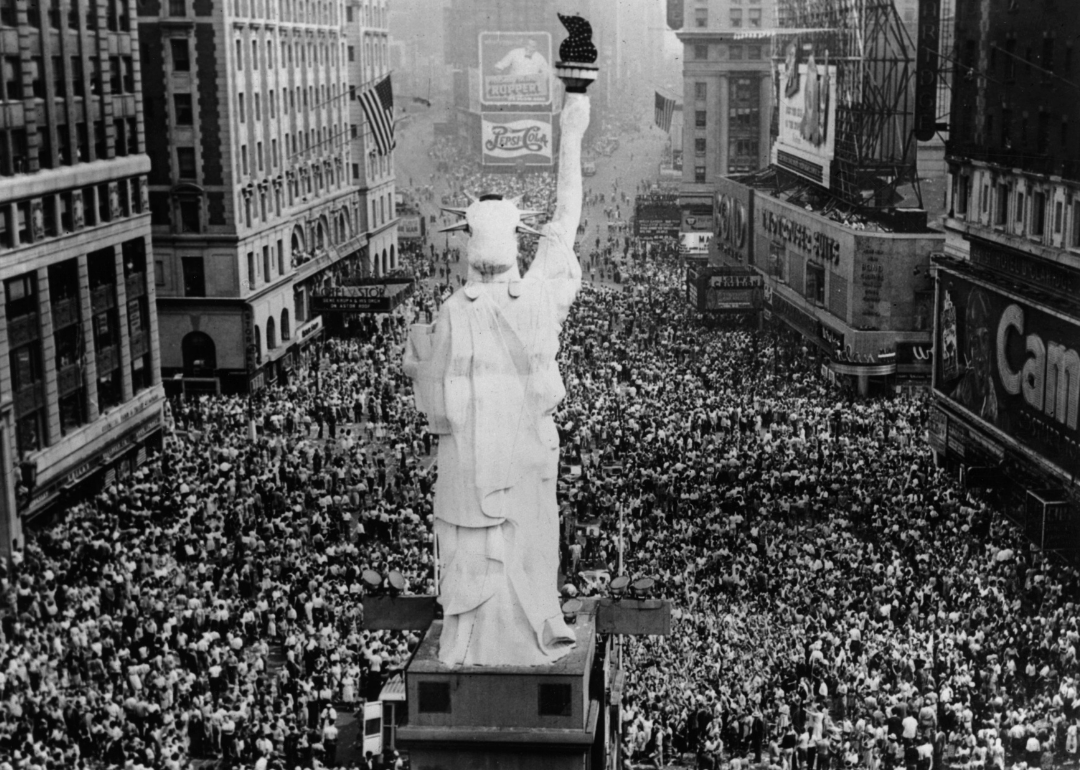
1945: Japan surrenders
Following the German surrender in May, the war officially ended on Sept. 2, 1945. Shown here are crowds cheering on Great White Way, New York City, as President Truman announces the formal signing of the Japanese Instrument of Surrender. A scaled-down version of the Statue of Liberty is in the foreground.
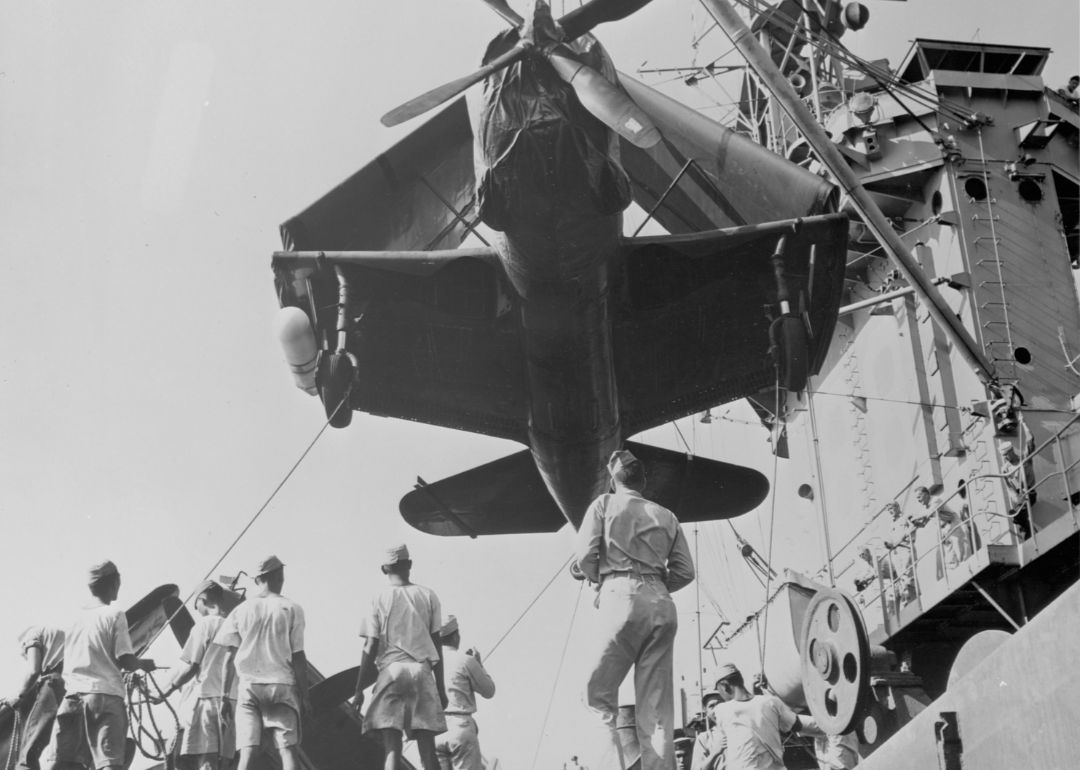
First Indochina War
From 1950 to 1954, the United States supported France in the First Indochina War, a conflict against anti-French insurgent groups in the then-socialist Democratic Republic of Vietnam backed by China and the Soviet Union. France had been embroiled in the conflict since 1946, but it was only after 1949 that the confrontations turned into a conventional war when the Allies introduced modern weaponry. At least 1 million people died in the hostilities, which served as a precursor to the Vietnam War.
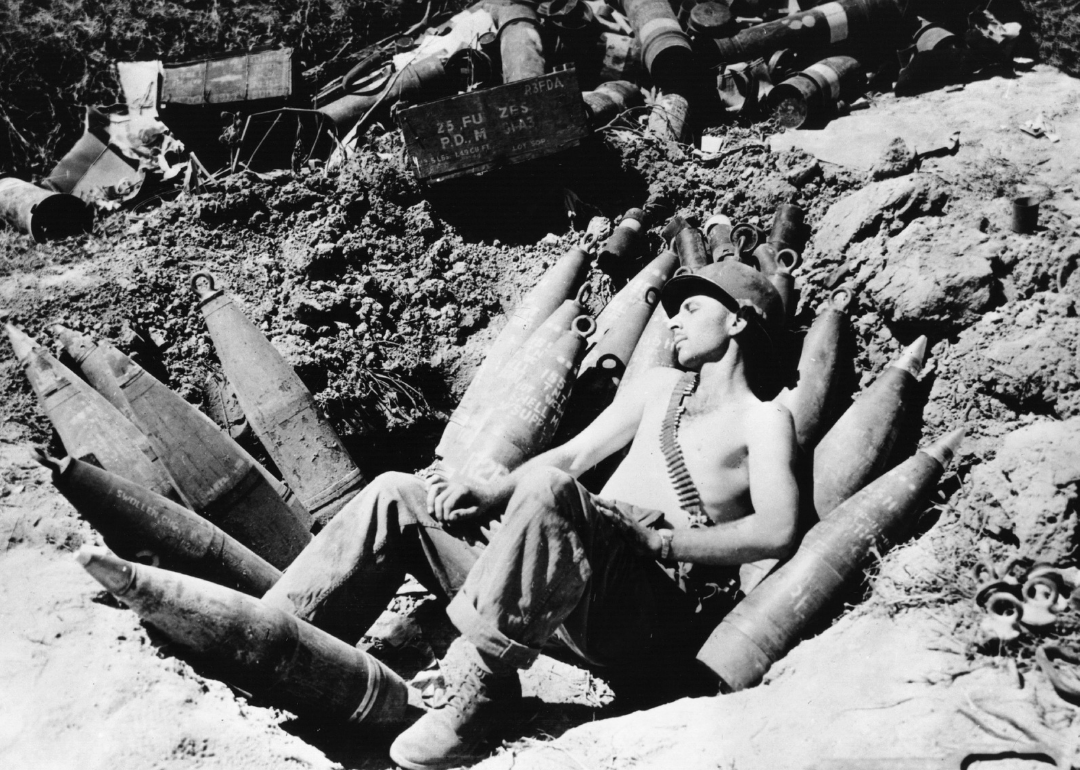
Circa 1950: Bed of shells
An American soldier is pictured here sleeping on his ammunition in the Mason area during the Korean War. The war began in 1950 with the invasion of South Korea by North Korea and ended in 1953 in a cease-fire agreement. The war never "officially" ended, however; the Korean peninsula remains divided to this day.
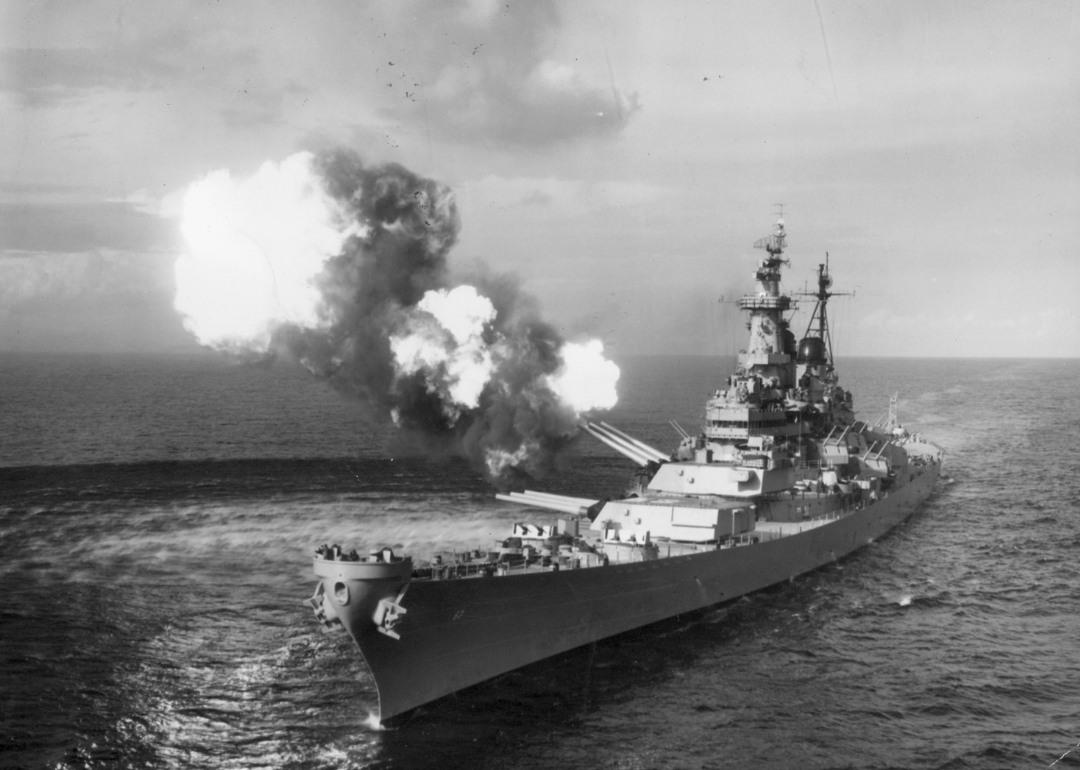
1951: The Mighty Mo
The battleship USS Missouri bombards Chongjin, North Korea, with her 16-inch guns during a mission to set out the lines of communication between the northern and southern parts of Korea during the Korean War. Chongjin is very close to the Soviet border and the Russian naval base at Vladivostok. Although millions of fighters perished during the war, the Korean War is known as "the forgotten war."
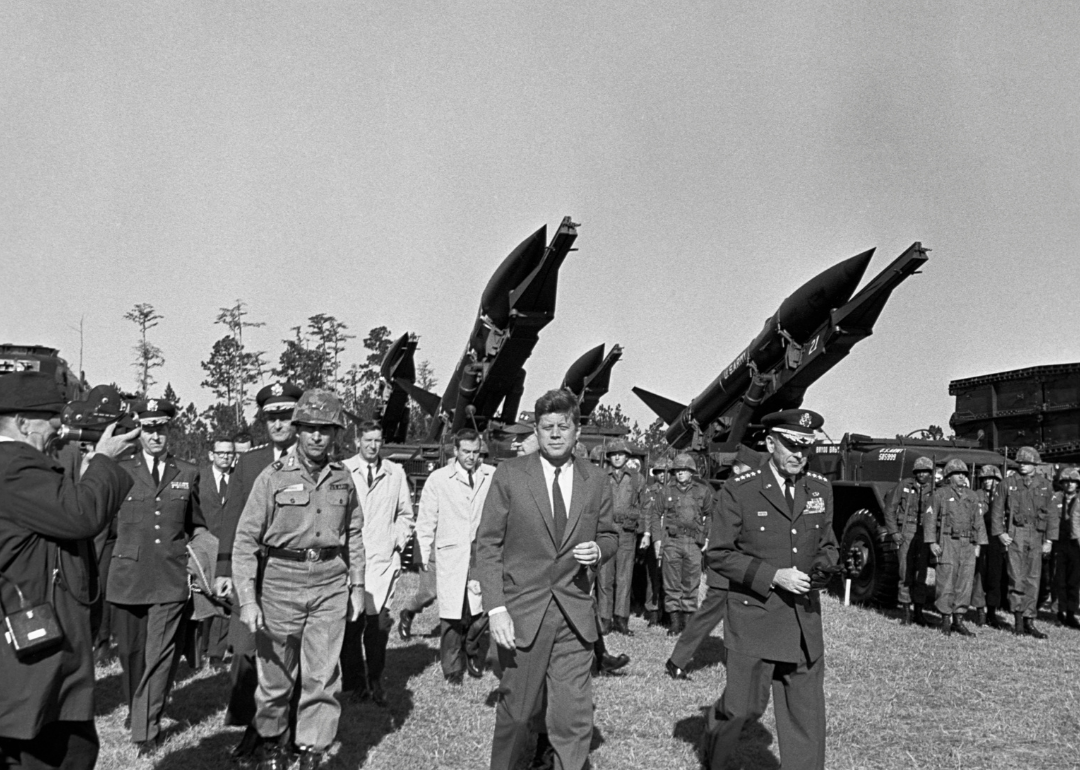
1962: Kennedy and military leaders
President Kennedy meets with U.S. Army officials during the Cuban Missile Crisis of late 1962. The crisis lasted only a matter of weeks and was perhaps the closest the United States and the USSR came to using nuclear weapons during the Cold War.
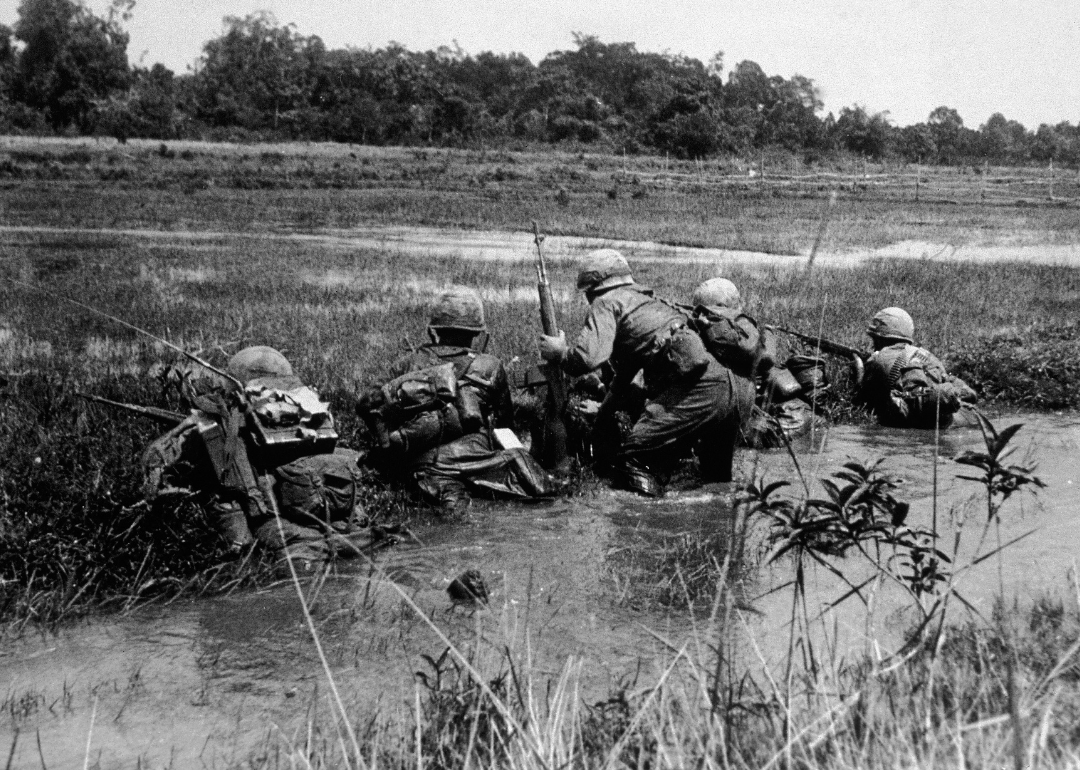
1965: US combat unit in Vietnam
U.S. Army combat platoon leader Second Lieutenant John Libs (center) of 2nd Platoon, C Company, 2nd Battalion, 16th Infantry Regiment, 1st Division, surveys the situation with his men from the relative safety of a watery rice paddy as they prepare to advance on a Viet Cong sniper position. Libs and the rest of 2nd Platoon participated in the battle of Xa Cam My/Operation Abilene in April 1966, during which Charlie Company suffered 82% casualties.
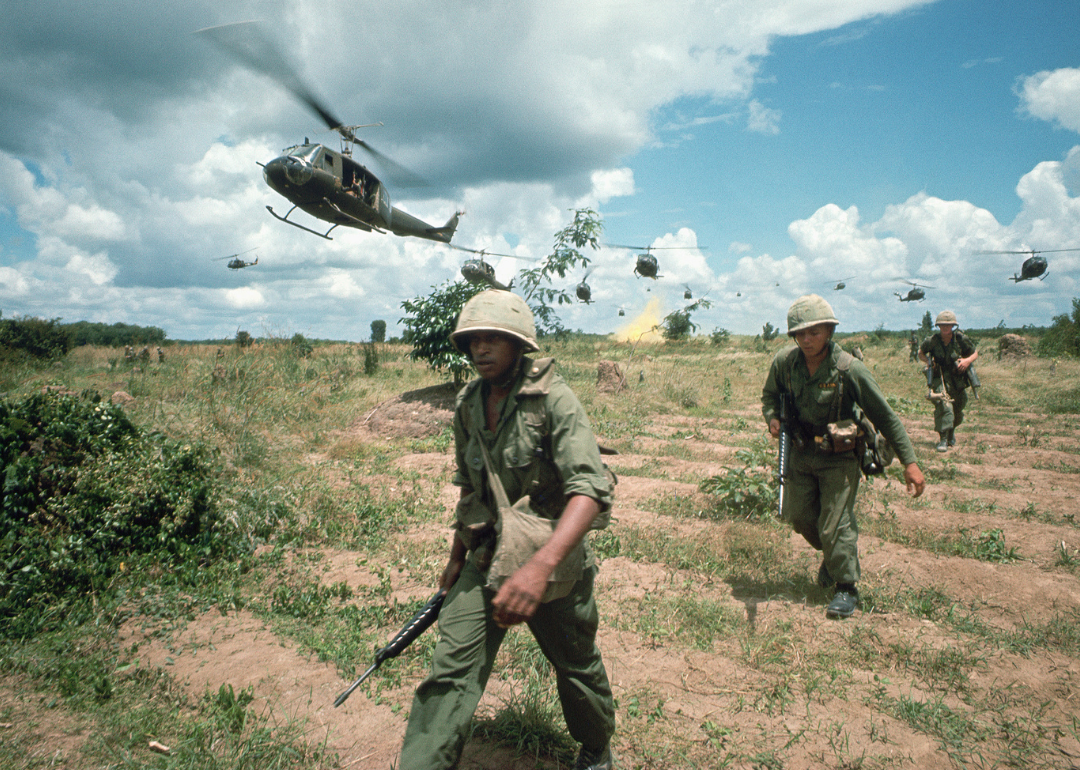
1965: US infantry
The U.S. 173rd Airborne is supported by helicopters during the Iron Triangle assault. The Iron Triangle was a strategic stronghold for the North Vietnamese and remained so until the war's end. Over 3 million U.S. service members were involved in the Vietnam War, which spanned 19 years.
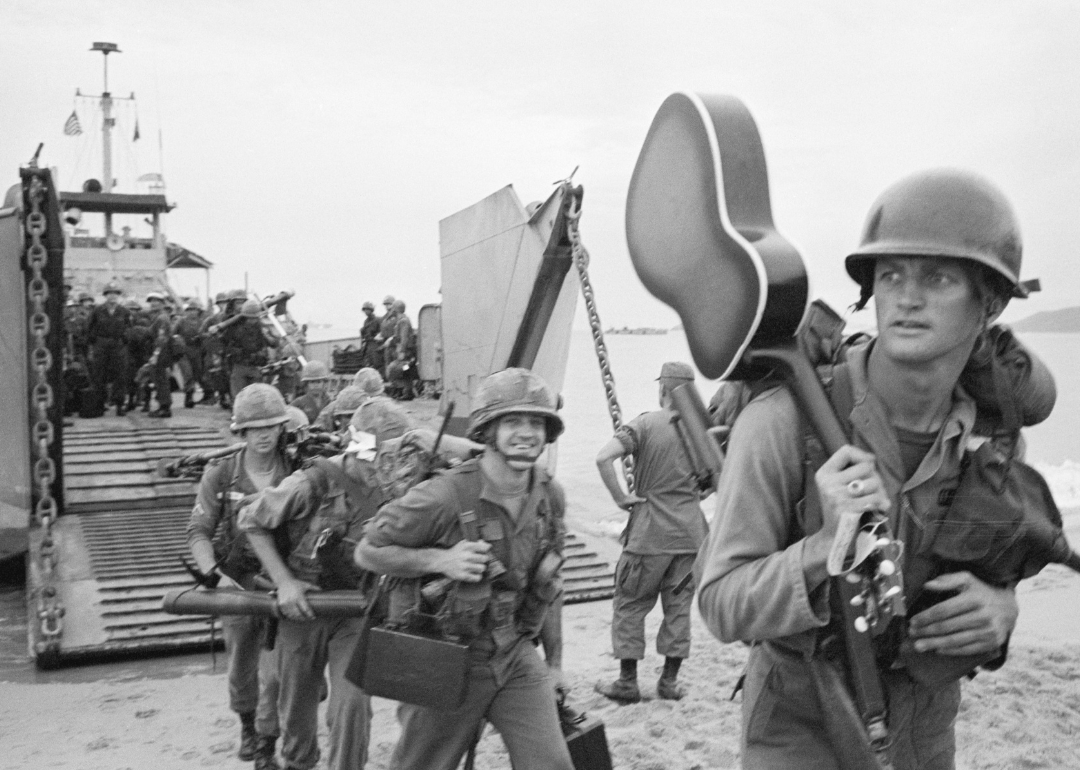
1965: American soldiers arriving in Vietnam
Guitar slung over his shoulder, a trooper of the United States 1st Cavalry walks ashore from a landing craft. More than 2,500 cavalrymen arrived in Vietnam, bringing the total of the Army's First Airmobile Division up to 16,000 men. By 1967, the number of U.S. troops deployed in Vietnam totaled 500,000.
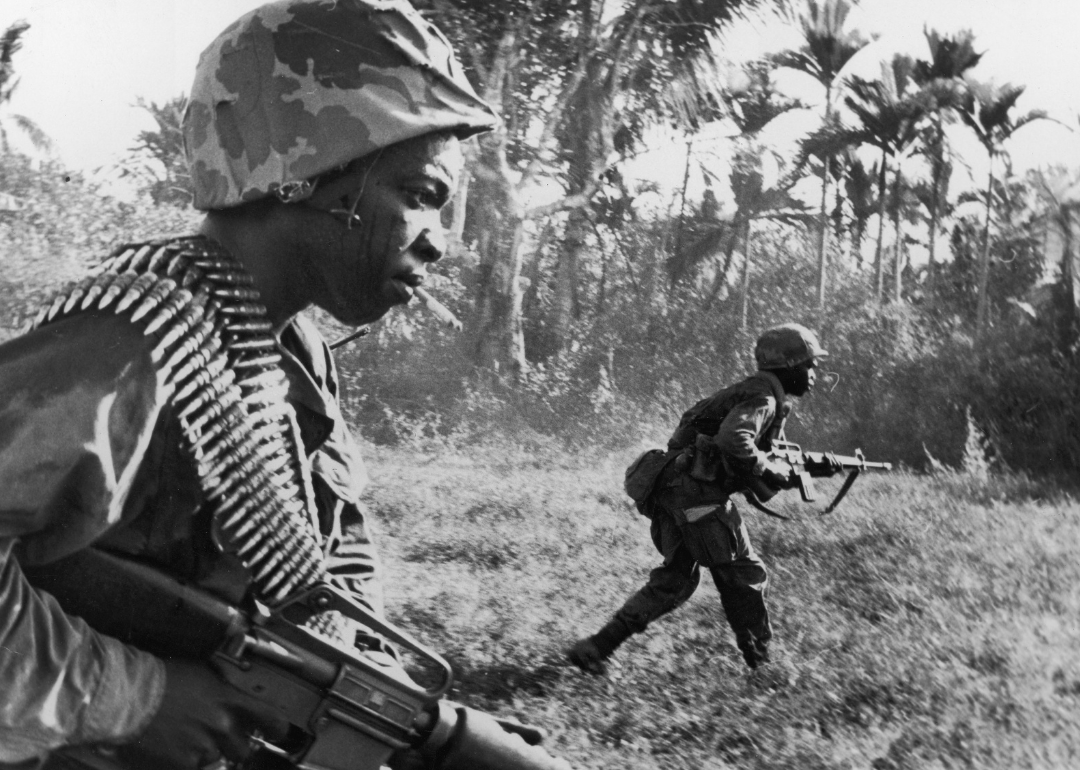
1967: US Army rifleman charge Viet Cong
U.S. riflemen from the 173rd Airborne Brigade charge toward Viet Cong positions, holding machine guns in a wooded area of War Zone D during the Vietnam War. Massive protests against the war efforts and the U.S.' involvement were spreading back home while the soldiers fought abroad.
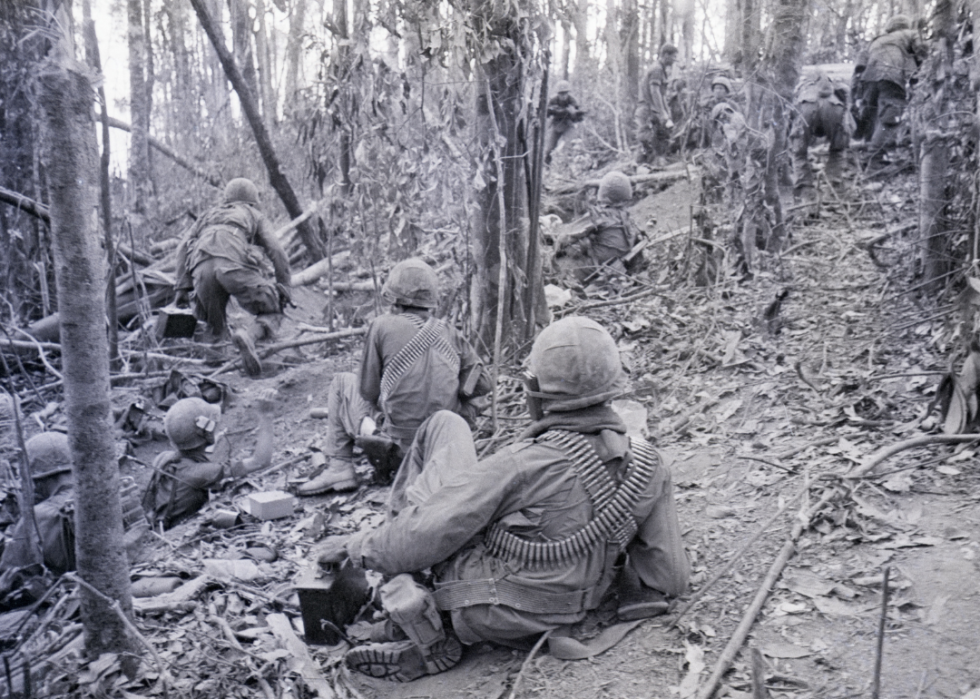
1967: Soldiers engaged in long crawl to crest
Members of the 173rd Airborne Brigade are engaged in a long crawl to the crest of Hill 875, a steep mound that in just four days of combat cost American forces some of their highest casualties of the war. Pushing inch-by-inch of sloping earth behind them, U.S. paratroopers seized most of the hill on Nov. 22. They were then faced with a North Vietnamese stronghold atop the peak and reports of two fresh regiments of NVA troops moving into the region.
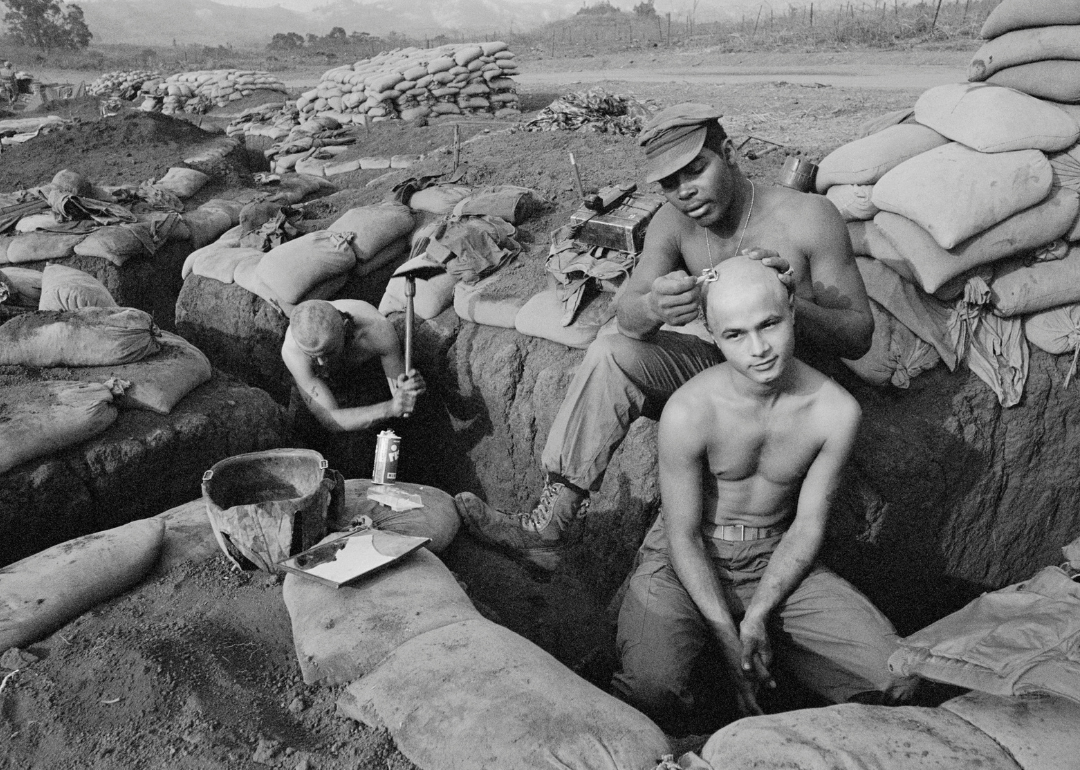
1968: Soldier shaving colleague's head
Hairstylist service was a rarity at the embattled Marine bastion of Khe Sanh, so Marine PFC Robert DuBois of Brooklyn, New York, did the honors for a buddy and shaved the head of Cpl. Efrain Torres of New York outside their bunker. Scores of Communist troops moving toward the Marines' fortress were killed in napalm and bombing attacks by Allied aircraft.
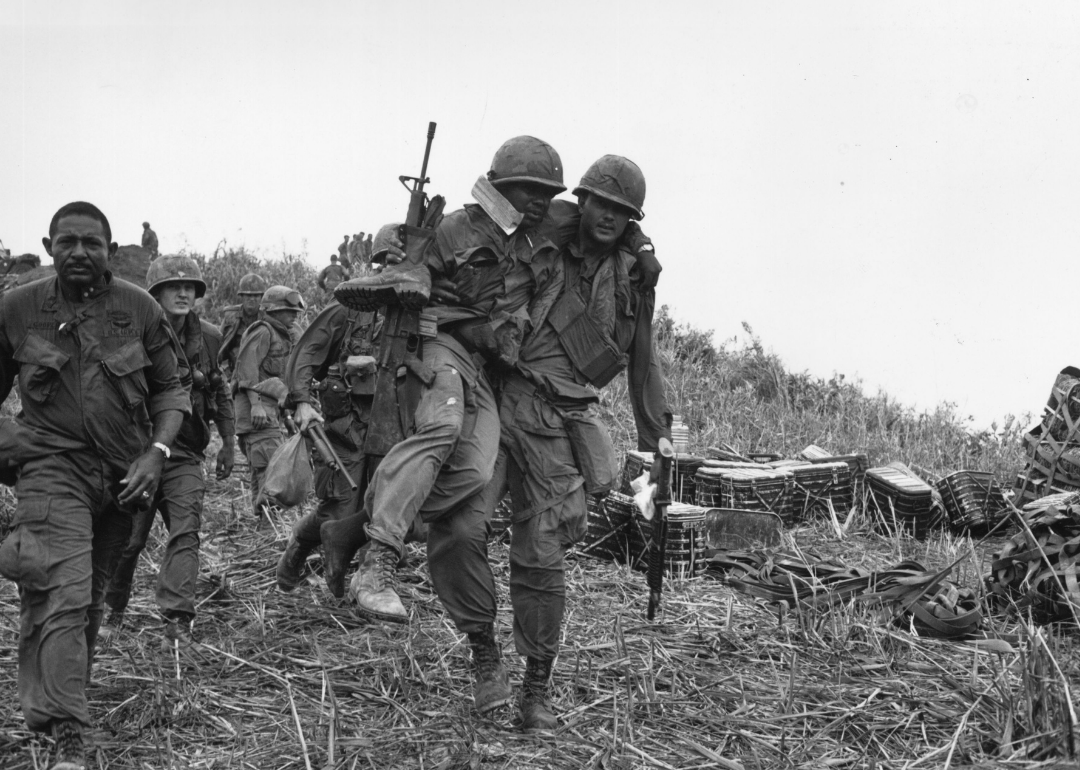
1968: Hill Timothy
U.S. soldiers, one wounded and being carried by a colleague, walking down Hill Timothy during the conflict in Vietnam. Almost 60,000 Americans died in Vietnam. The unconventional ways of fighting, and the knowledge the Vietnamese had about their own terrain, led to the United States removing troops without completing their objectives.
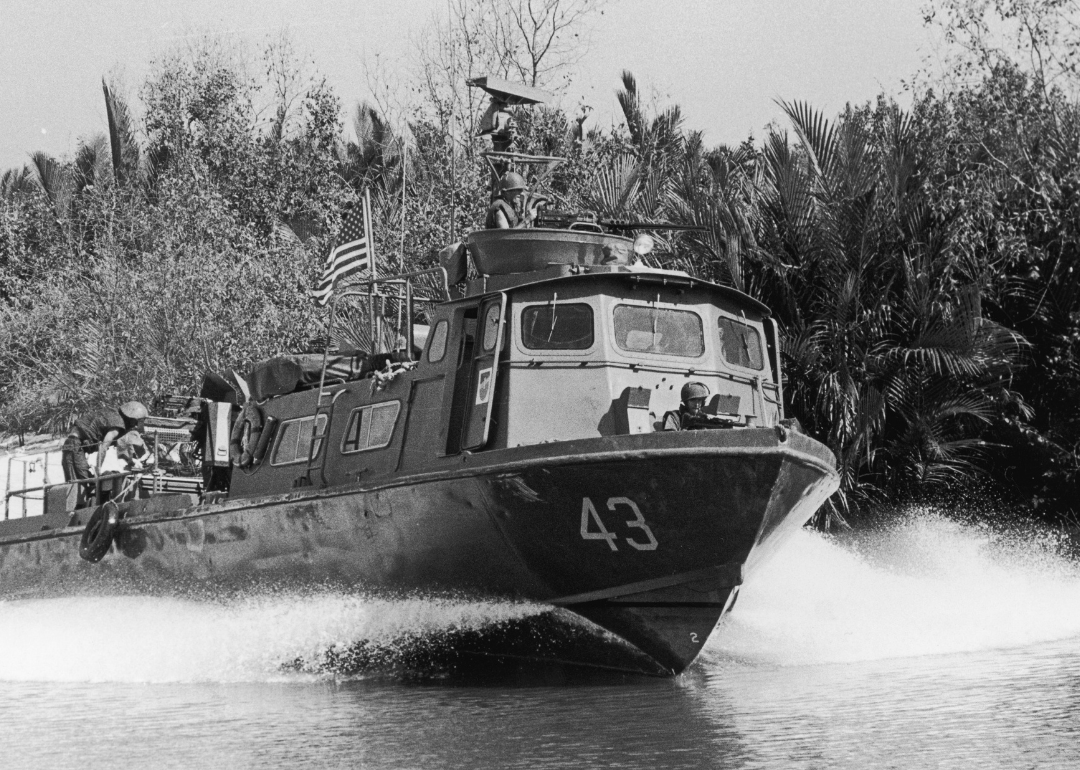
1969: Naval patrol craft
Navy inshore patrol craft (PCF) 43 cruises along a riverbank in the Republic of Vietnam during Operation Slingshot in the Vietnam War. Patrol boats like this one were used to transport troops and secure areas along the Mekong Delta.
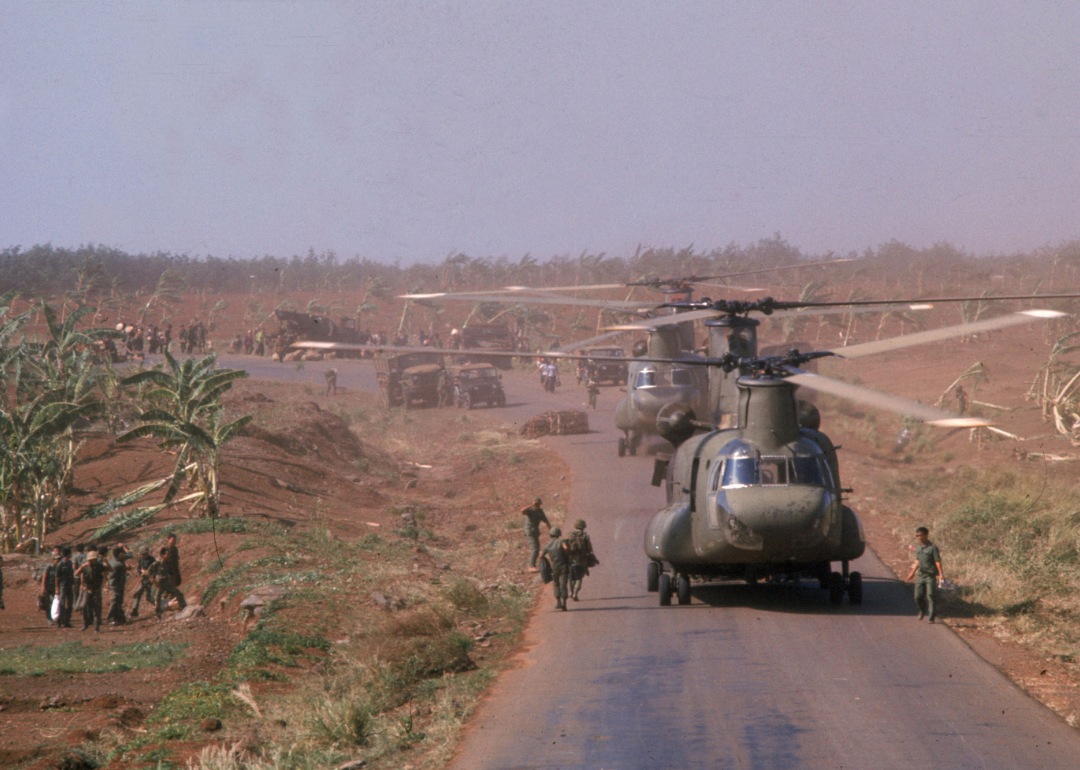
1975: The fall of Saigon
American military Chinook helicopters helped with the evacuation of Saigon in April 1975. America's involvement in the Vietnam War ended as troops from communist North Vietnam invaded Saigon, the capital of the Republic of Vietnam in the South. Chinook helicopters first saw battle in the Vietnam War and were known for their speed and ability to carry large numbers of people.
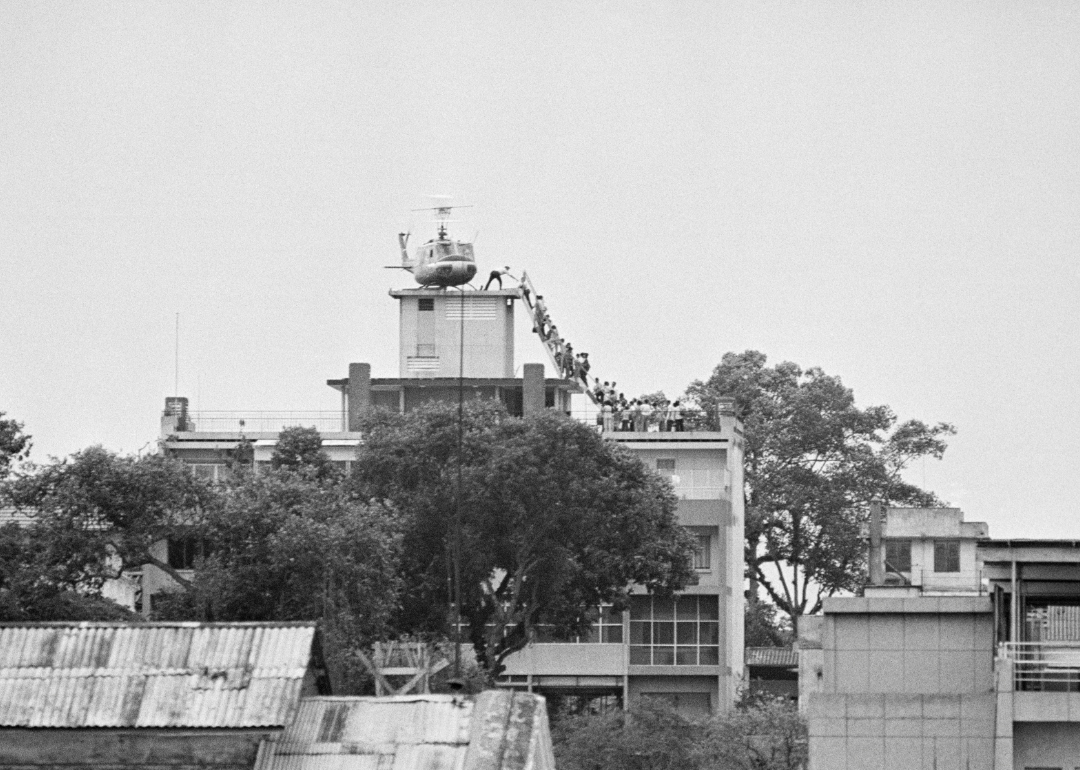
1975: Evacuation
A CIA employee (thought to be O.B. Harnage) helps Vietnamese evacuees onto an Air America helicopter from the top of 22 Gia Long Street, a half-mile from the U.S. Embassy. The fall came two years after the Paris Peace accords, which saw the U.S. leave the conflict. This moment is also known as the "Liberation of Saigon."
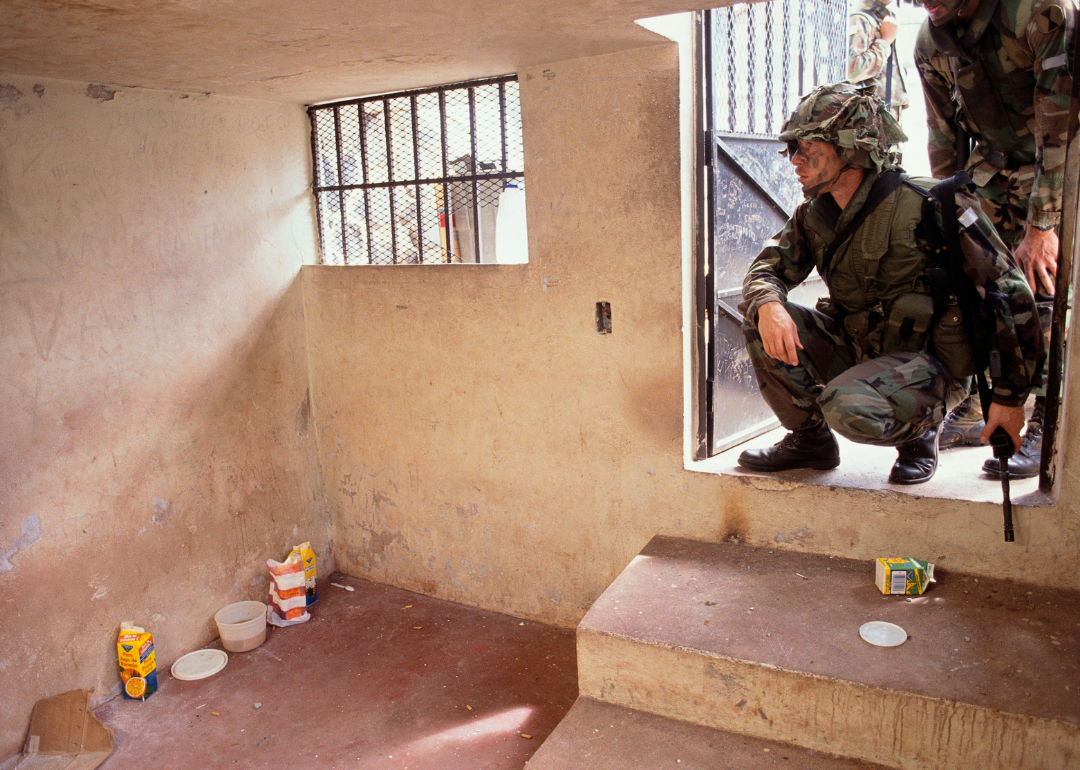
1989: US soldiers look into a prison cell
American soldiers look inside a secret police prison cell during the invasion of Panama. The United States invaded Panama in 1989 to bring leader Manuel Noriega back to the U.S. to face charges of racketeering, drug trafficking, and money laundering while making way for the rise of the democratically elected leader, Guillermo Endara.
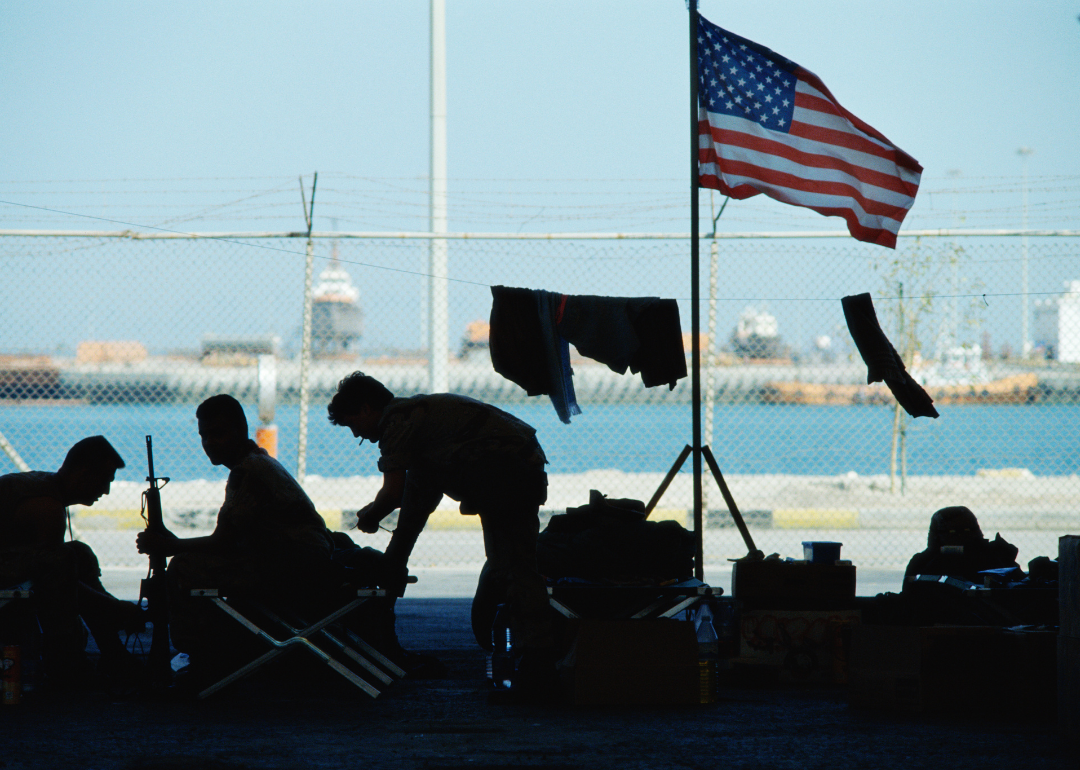
1990: Operation Desert Shield
U.S. Marines make camp beside the Stars and Stripes in Dhahran, Saudi Arabia, during the Gulf War in December 1990. Operation Desert Shield began after the invasion of Kuwait by Saddam Hussein. The operation turned into Operation Desert Storm when efforts at diplomatic resolution failed.
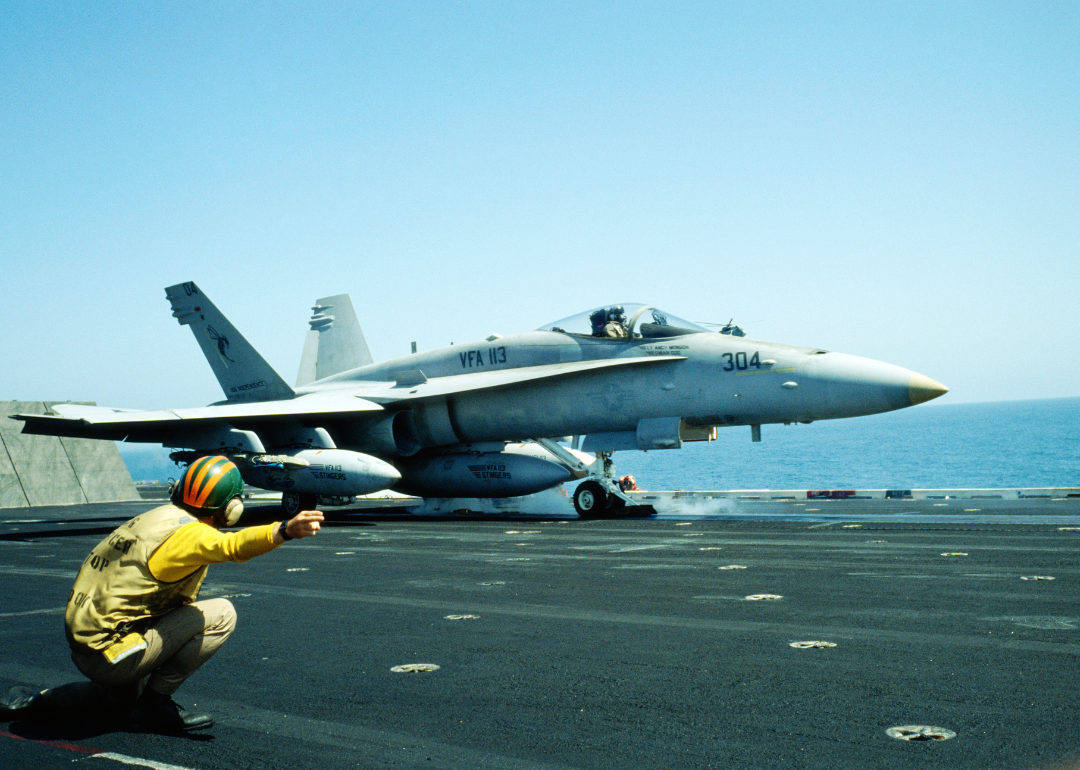
1990: Persian Gulf War
Deck crew and an F-15 aircraft from the tactical fighter wing taking off from the aircraft carrier USS Independence in Dhahran, Saudi Arabia, to carry out a mission over Kuwait during the Gulf War in December 1990. Operation Desert Storm involved the largest use of United States military aircraft since the war in Vietnam. The U.S. and its allies dropped over 80,000 bombs during the offensive.
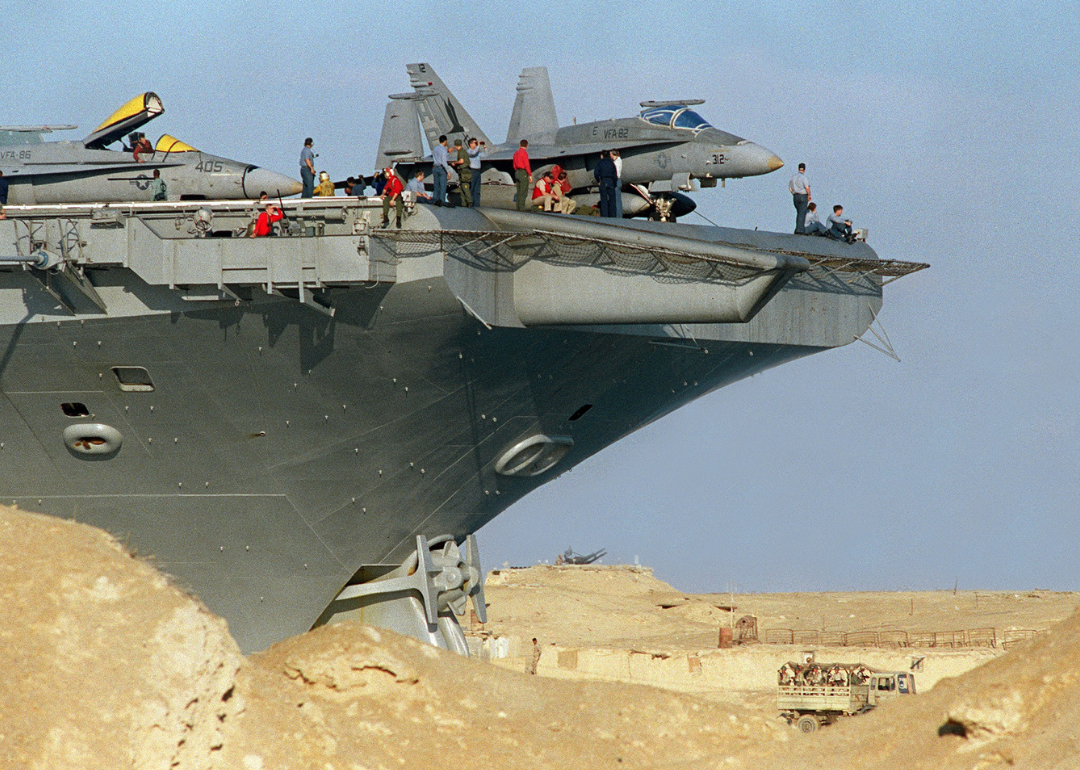
1991: USS America
The bow of the aircraft carrier USS America looms above the sand dunes along the Suez Canal on Jan. 15, 1991, as an Egyptian army truck and anti-aircraft position guard the strategic waterway. USS America is shown here making its way toward the Red Sea to be on alert in the Iraq-Kuwait conflict.
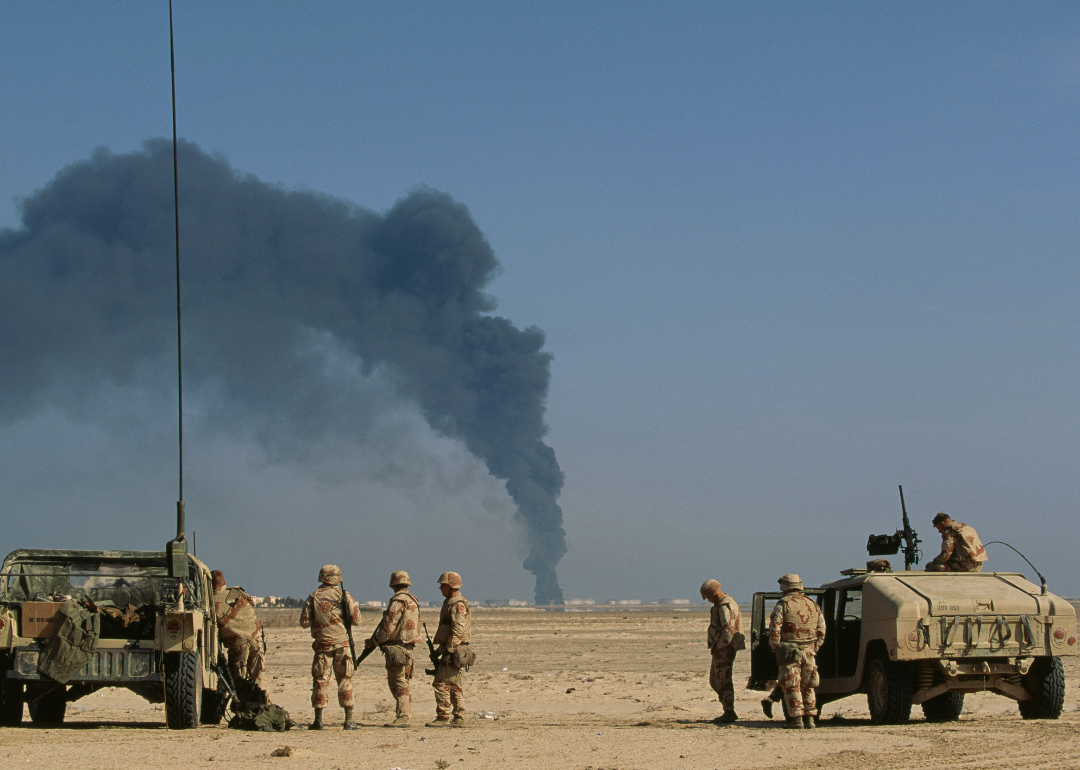
1991: US soldiers watch oil refinery burn
U.S. soldiers arrive at a burning oil refinery in Al-Khafji, Saudi Arabia, near the Kuwait border, after Iraqi bombardment during the Gulf War. Over 600,000 troops participated in the war effort, with nearly 300 being killed. The burning of the oil fields had a toxic impact on soldiers, who reported symptoms and pain involving the lungs and eyes.

1991: Kuwaitis with American soldiers
American soldiers have tea with Kuwaiti citizens during Operation Desert Storm. Americans have continued to be viewed favorably by Kuwaitis, and the two nations have maintained strong diplomatic ties since the Gulf War ended in 1991.
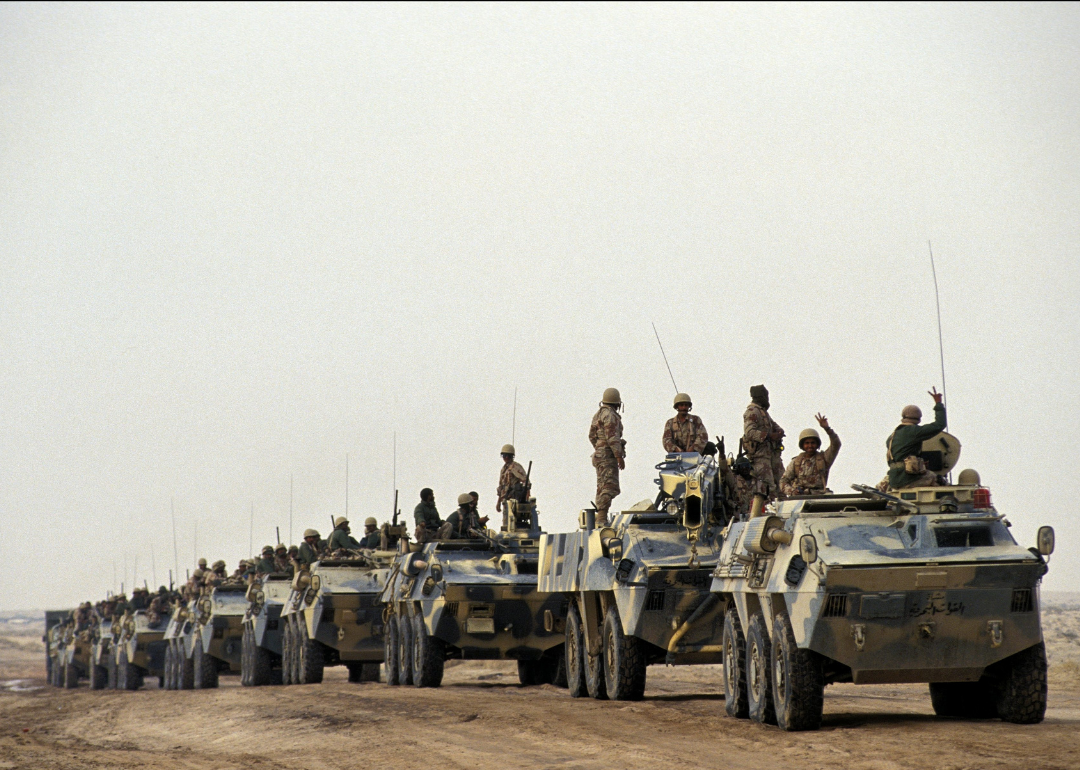
1991: The border Kow in Saudi Arabia
Once the offensive against Iraqi leader Saddam Hussein began, it didn't last long. Within a single day, the United States and its allies controlled the airspace in the region. Hussein fired airstrikes at strategic positions in Saudi Arabia in response. The UN passed a ceasefire on March 2, which included sanctions and a requirement to pay for damages inflicted during the war.
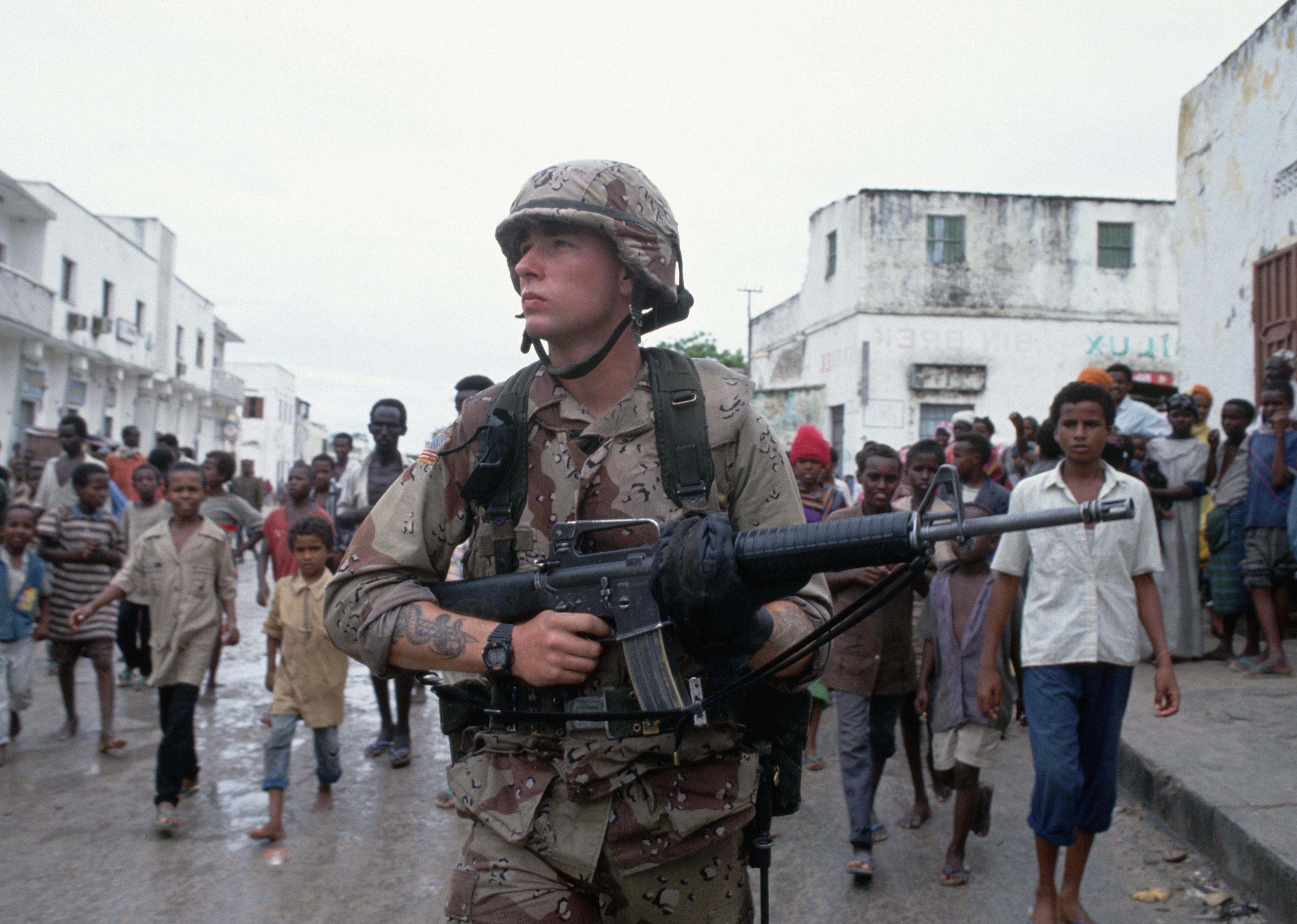
1992: Intervention in Somali Civil War
In December 1992, during his final weeks in office, President George H.W. Bush dispatched U.S. troops to Somalia to assist with famine relief efforts. The presence of American service members jeopardized the power of warlord Muhammad Farah Aideed. In October 1993, Aideed's forces shot down two U.S. helicopters, killing 18 American soldiers and hundreds of Somalis. President Bill Clinton pulled the troops out of combat and by March 1994, they were out of the African country. The United Nations withdrew from Somalia a year later.
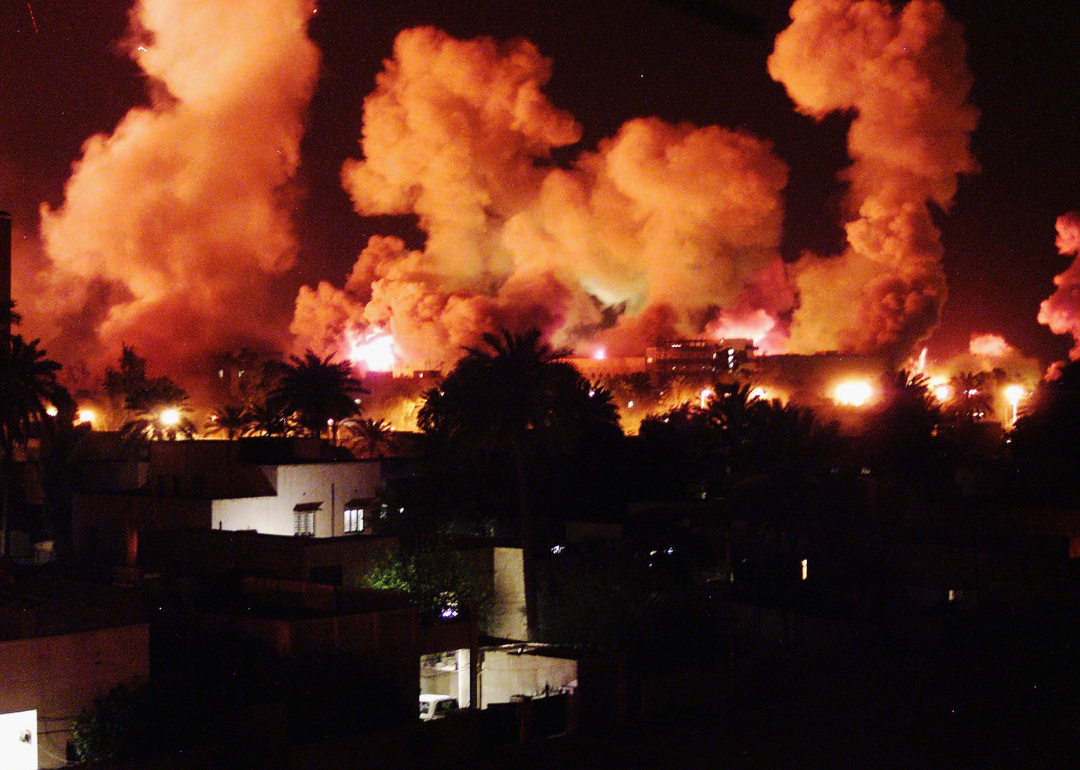
2003: Shock and awe
Smoke rises from explosions during the first few minutes of a massive air attack on March 21, 2003, in Baghdad, Iraq. Though Iraqi President Saddam Hussein was captured later that year, combat missions in Iraq wouldn't end until 2011. The conflict left over 30,000 civilians dead.
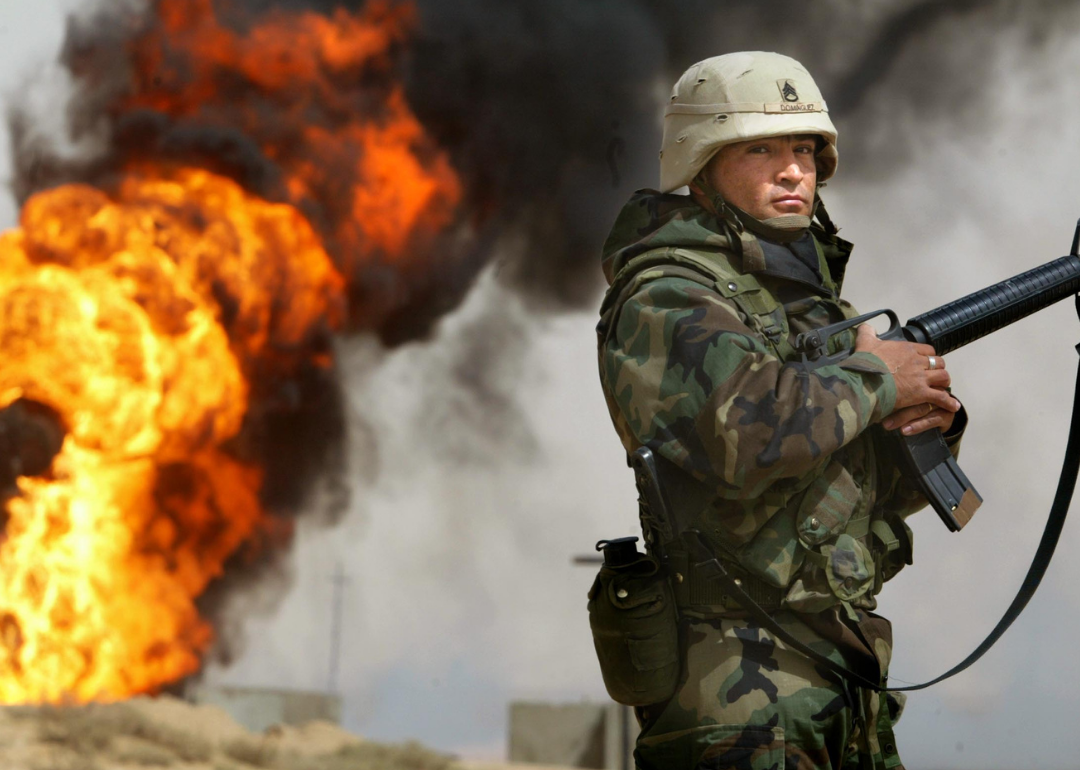
2003: Oil fires burn in Iraq
U.S. Army Staff Sergeant Robert Dominguez of Mathis, Texas, stands guard next to a burning oil well at the Rumaila oil fields in Iraq. Several oil wells were set ablaze by retreating Iraqi troops in the area—the second-largest offshore oilfield in the country—near the Kuwait border.
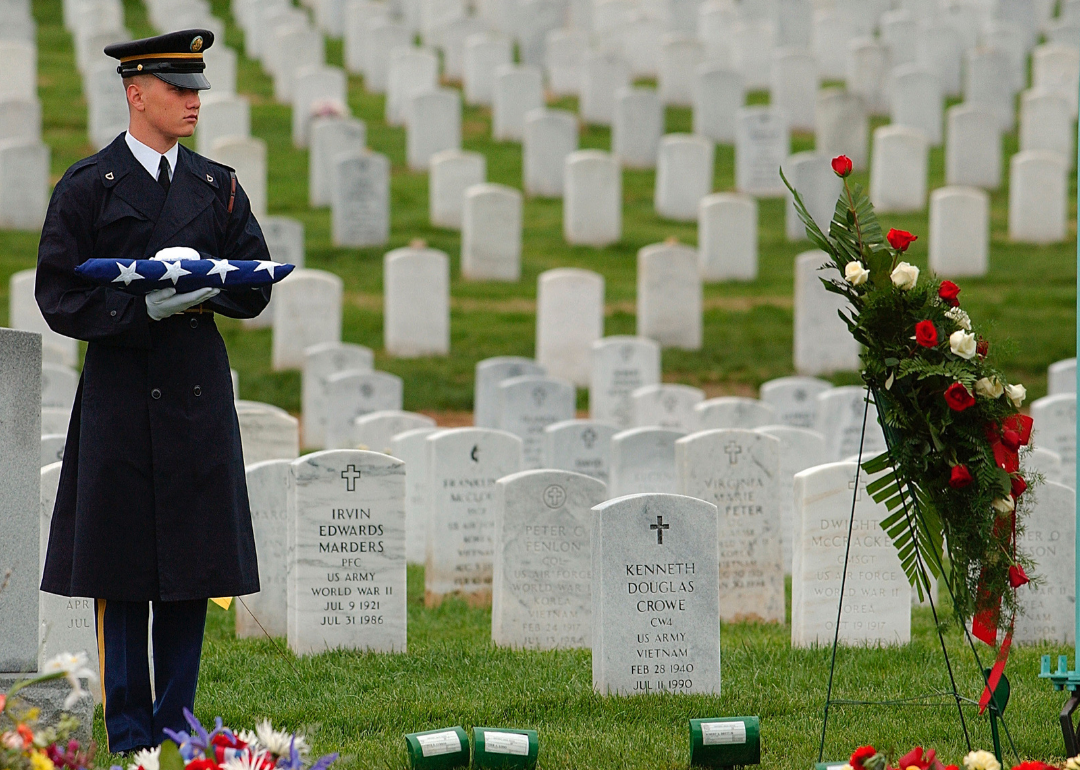
2003: Families mourn soldiers killed during war with Iraq
An honor guard member holds an American flag as he waits for the funeral of U.S. Army Sergeant First Class Wilbert Davis at Arlington National Cemetery on April 18, 2003, in Arlington, Virginia. Davis was killed on April 3, 2003, in a vehicle accident in Iraq, along with journalist Michael Kelly. Suicide bombers and improvised explosive devices, or IEDs, caused numerous deaths during the war.

2003: The fall of Baghdad
U.S marines and Iraqis are seen on April 9, 2003, as the statue of Iraqi dictator Saddam Hussein is toppled at Al-Fardous Square in Baghdad, Iraq. After the fall of Baghdad, and the arrest of Hussein, the people of Iraq participated in democratic elections to install new leadership for the country.
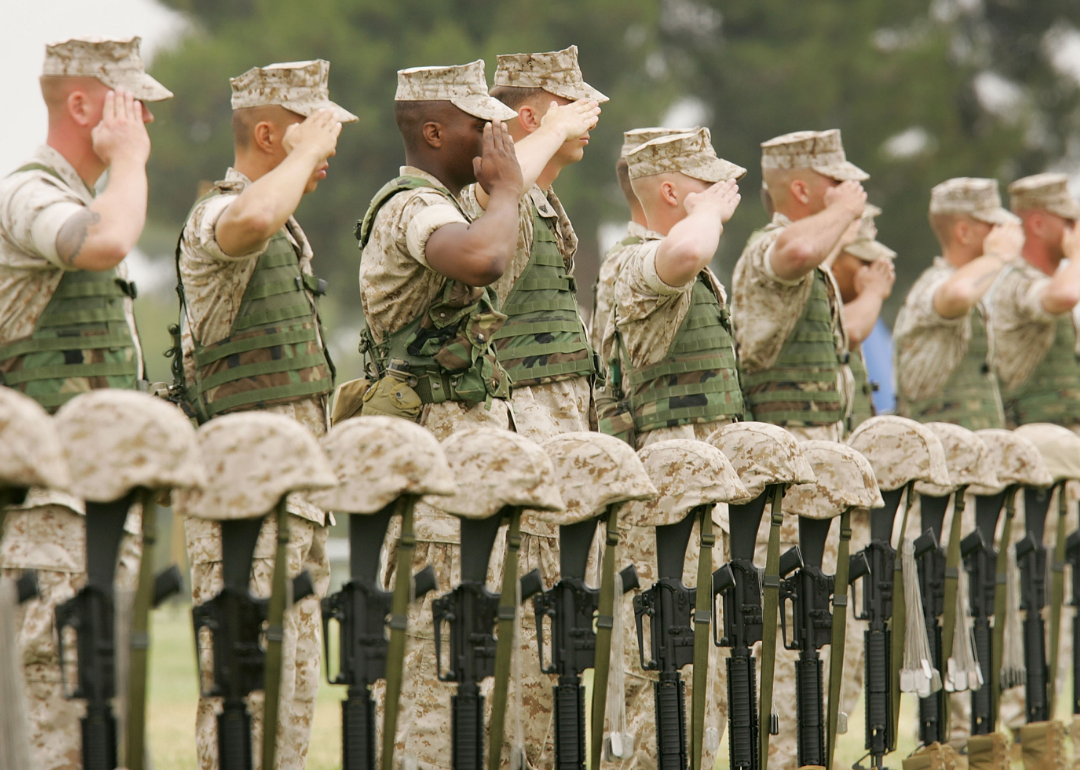
2005: 1st Marine division honors comrades killed in Iraq
U.S. Marines at Camp Pendleton, California, salute behind memorials to their fallen comrades at a service memorializing the 420 soldiers, sailors, Marines, and British soldiers who lost their lives while serving with the 1st Marine Division in support of Operation Iraqi Freedom. The 1st Marine Division had recently completed a year-long deployment to Iraq, serving in the Al Anbar Province from March 2004 to March 2005.
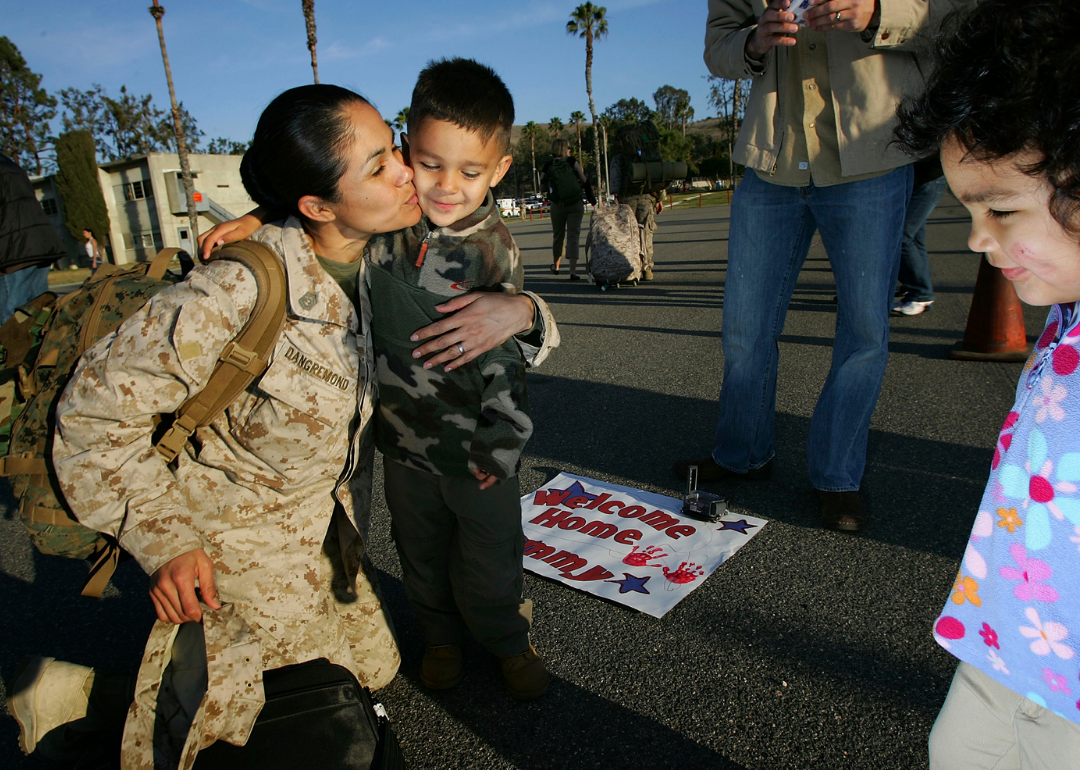
2006: Marines return after one-year deployment to Iraq
Gunnery Sergeant Deborah Dangremond kisses her son Tyler, age 4, as her daughter Basia, age 3, looks on. Marines and sailors of the 1st Marine Logistics Group were returning home from a 12-month deployment to Iraq on Feb. 2, 2006, at Camp Pendleton, California. The 1st MLG provided logistical support to the ground fighters, such as maintenance, supply, medical care, and other necessary elements of daily existence in a combat zone to keep the fighters on the frontlines.
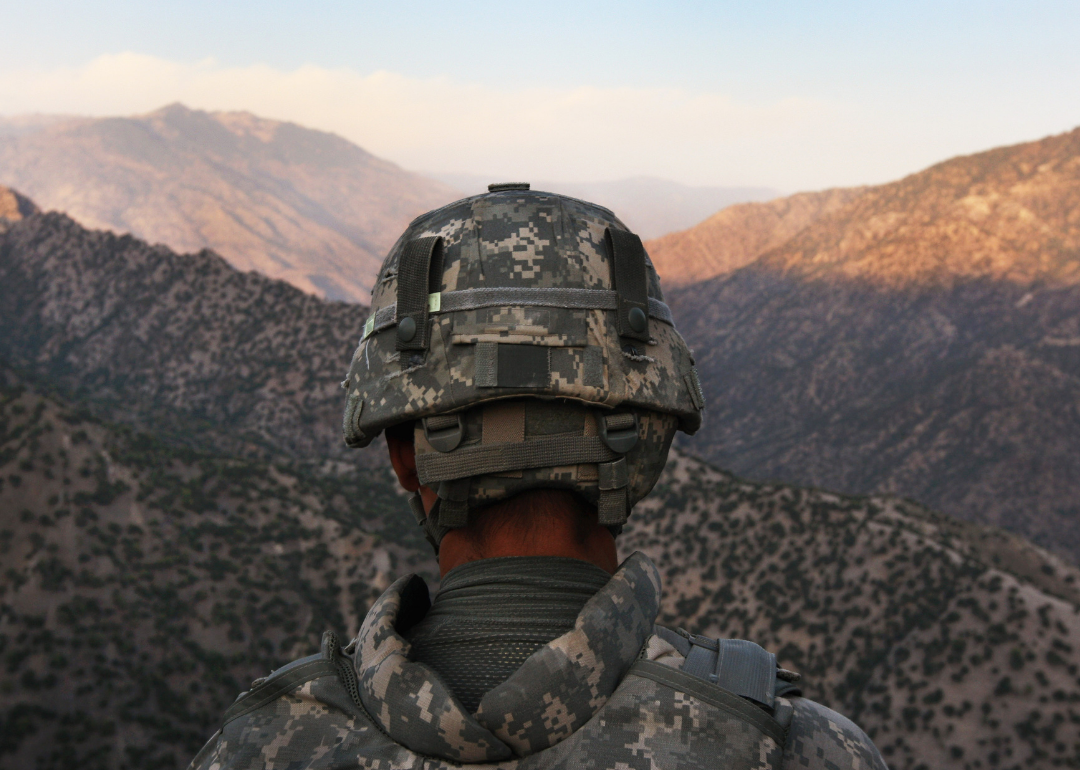
2008: US Army battles Taliban in Kunar Province
U.S. Army First Lieutenant Matthew Hernandez looks down the Korengal Valley from a mountaintop outpost on Oct. 24, 2008, in the Kunar Province of eastern Afghanistan. The remote and isolated area was the site of some of the heaviest fighting between U.S. forces and Taliban insurgents.
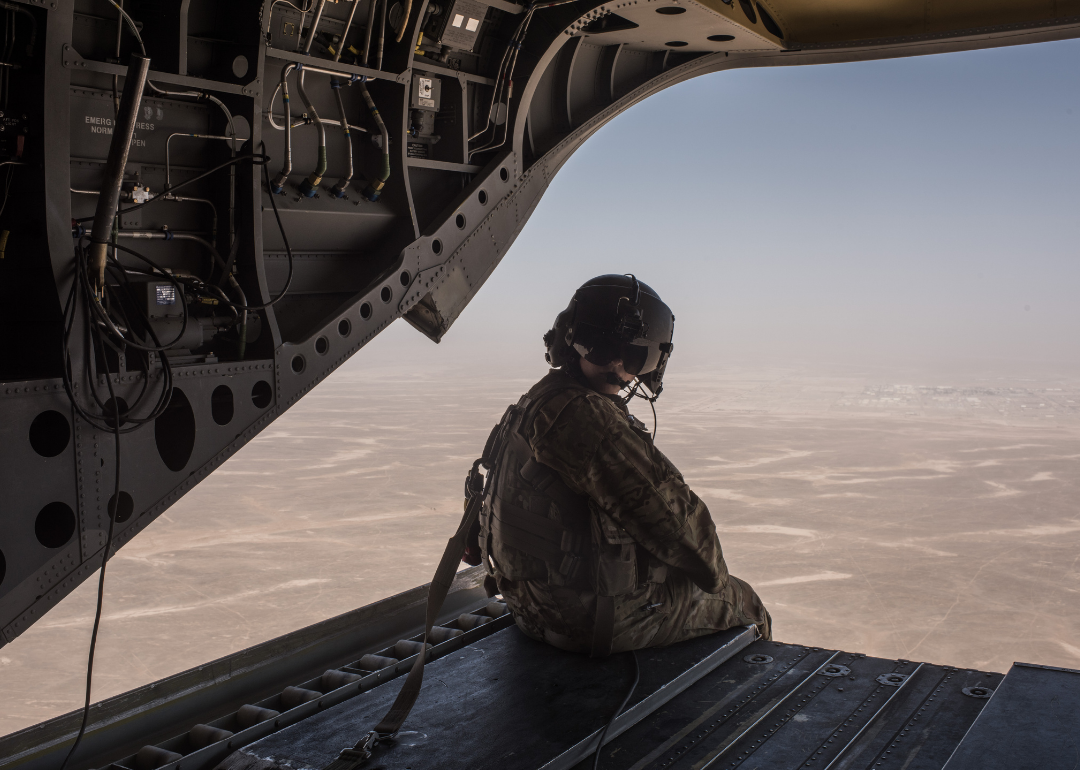
2017: United States in Afghanistan
A U.S. Army helicopter flies outside Camp Shorab on a flight to Camp Post on Sept. 11, 2017, in Helmand Province, Afghanistan. About 300 marines were deployed in Helmand Province to train, advise, and assist local Afghan security forces. At this point, the United States had about 11,000 troops deployed in Afghanistan, with a reported 4,000 more expected to arrive in the coming weeks.
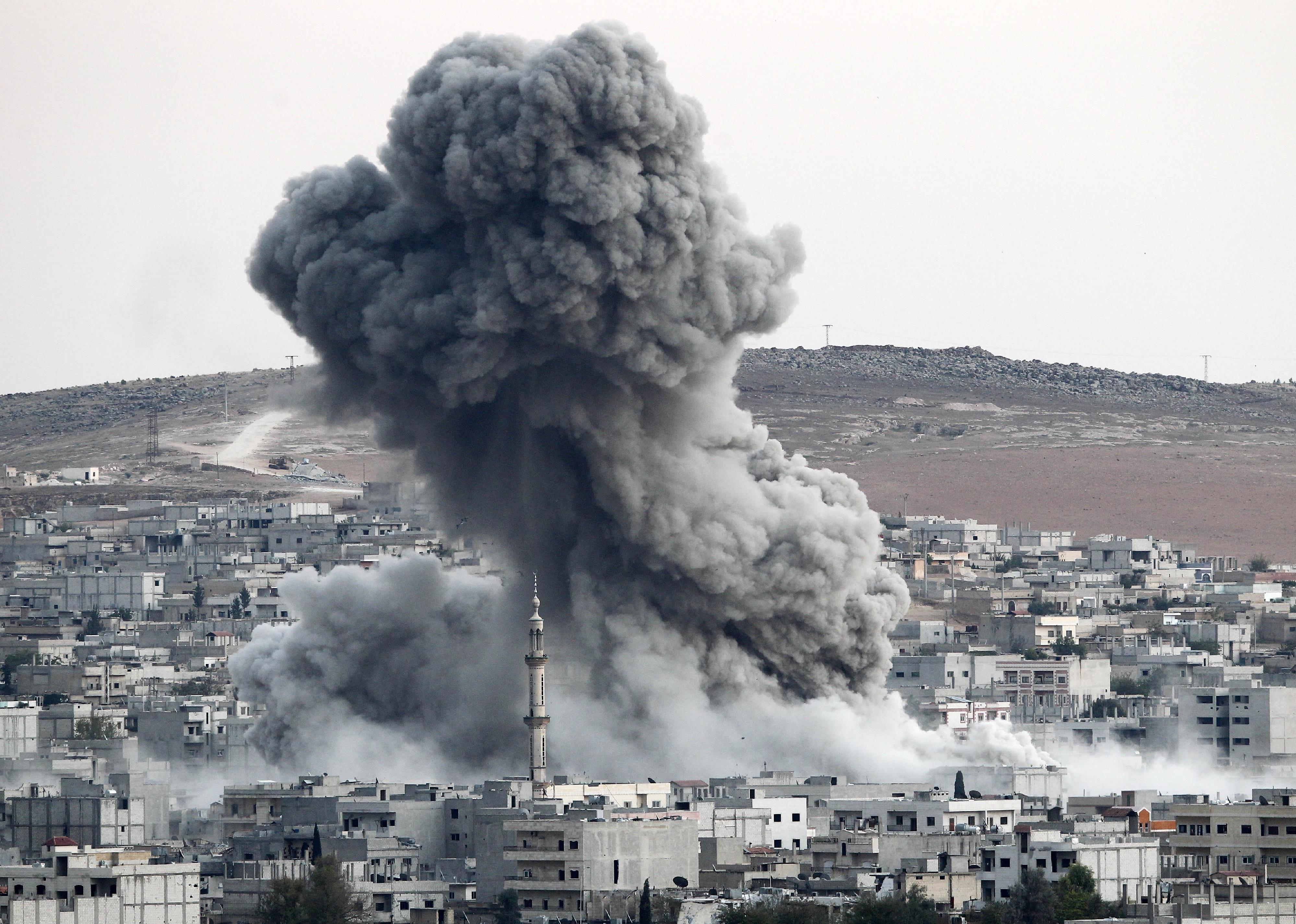
2014: Airstrikes targeting Islamic State group
A U.S.-led coalition carried out airstrikes in Syria against the Islamic State group in 2014 and the years that followed. By April 2016, it had carried out over 10,000 airstrikes intended to help local forces regain territories taken by the terrorist organization.
Supported by the coalition's airpower, Iraqi security forces recovered control of Mosul in July 2017, and the Syrian Democratic Forces captured Raqqa in October 2017. In December of that year, Iraqi Prime Minister Haider al Abadi declared victory over the Islamic State group in Iraq. While in March 2019, the SDF regained the jihadist group's last enclave: Baghouz, ending the organization's caliphate in Syria.
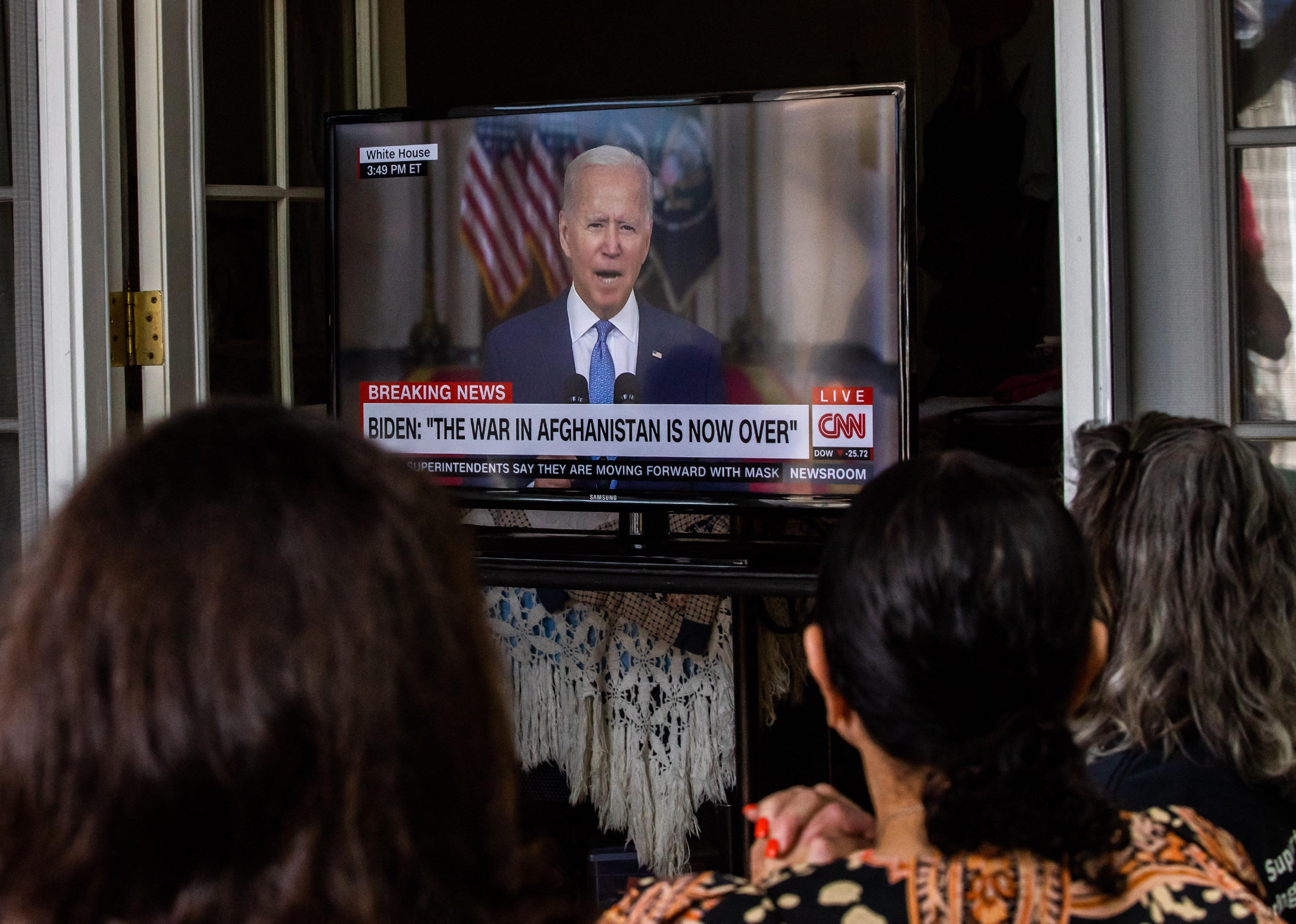
US leaves Afghanistan
President Joe Biden ordered the withdrawal of U.S. troops from Afghanistan in July 2021. A month later, the 20-year presence of American militaries in the Middle Eastern country ended. The Taliban regained control of the country soon after, and a refugee crisis developed in neighboring nations and beyond as thousands of Afghans fled the nation. The withdrawal raised concerns that terrorists would use Afghanistan as a safe haven—a fear that held up as Ayman al-Zawahiri, an al-Qaeda leader, was discovered and killed in Kabul by a U.S. drone strike a year after the troops had left.
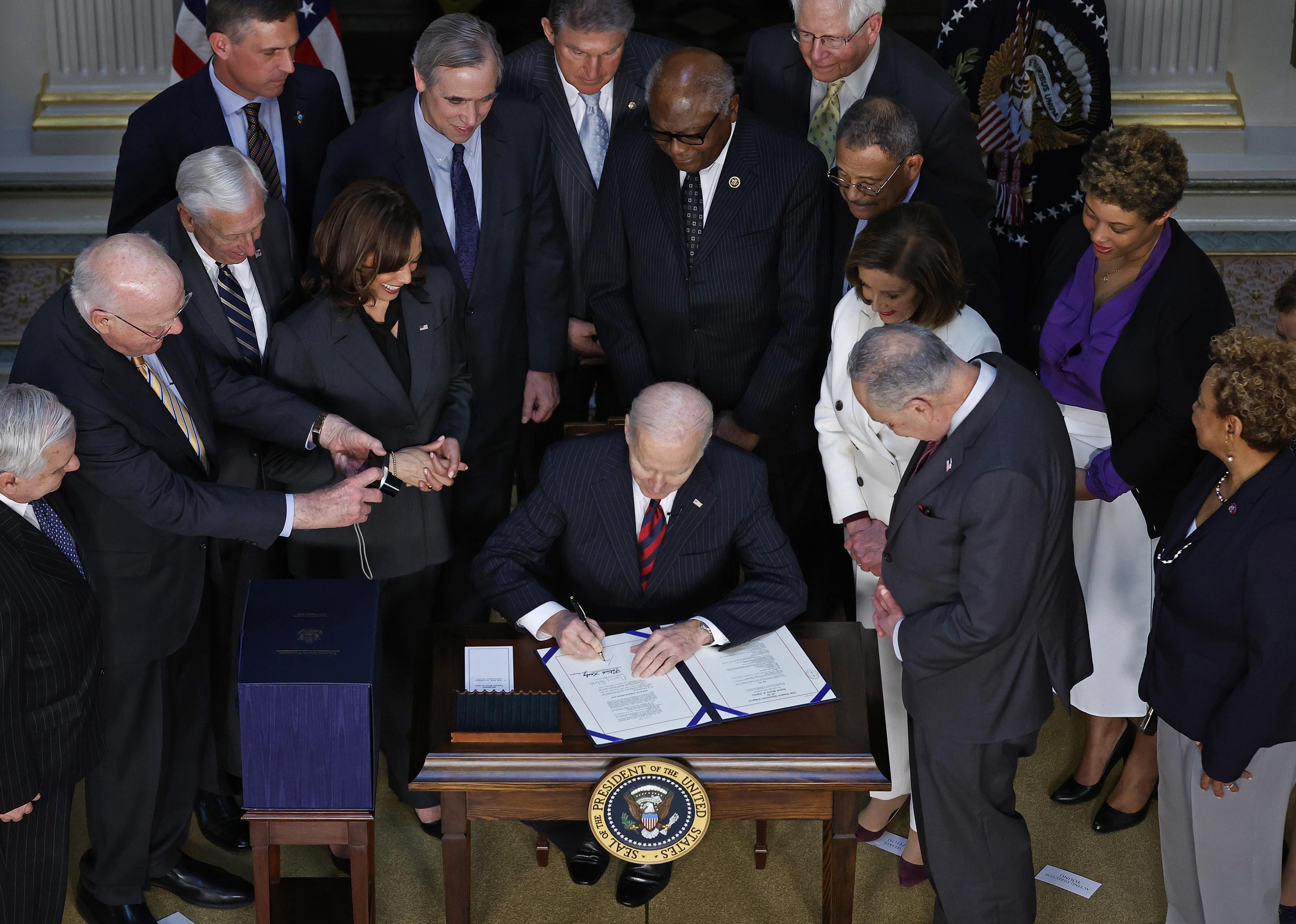
US sends aid to Ukraine
A few weeks after Russian troops invaded Ukraine, President Joe Biden announced that the U.S. would send arms, equipment, food, and medical and financial aid to the Eastern European country. In 2022, the aid reached almost $50 billion. Military assistance—including weapons, security assistance, and grants for equipment—took up 48% of the aid. Financial support added up to 31% of the total, while 21% was allocated to humanitarian relief.



